Strategic Management of Aldi: Approaches and Strategies
VerifiedAdded on 2022/12/22
|23
|5877
|46
AI Summary
This report discusses the strategic management of Aldi, a discount supermarket chain. It explores the different emergent approaches and strategy formulation of Aldi to maintain balance. It also examines the impact of macro environment on Aldi's activities and its responses. The report further analyzes Aldi's strategic capabilities using Porter's Value Chain Model and VRIO model, and discusses Porter's generic strategies and Ansoff Matrix of Aldi.
Contribute Materials
Your contribution can guide someone’s learning journey. Share your
documents today.
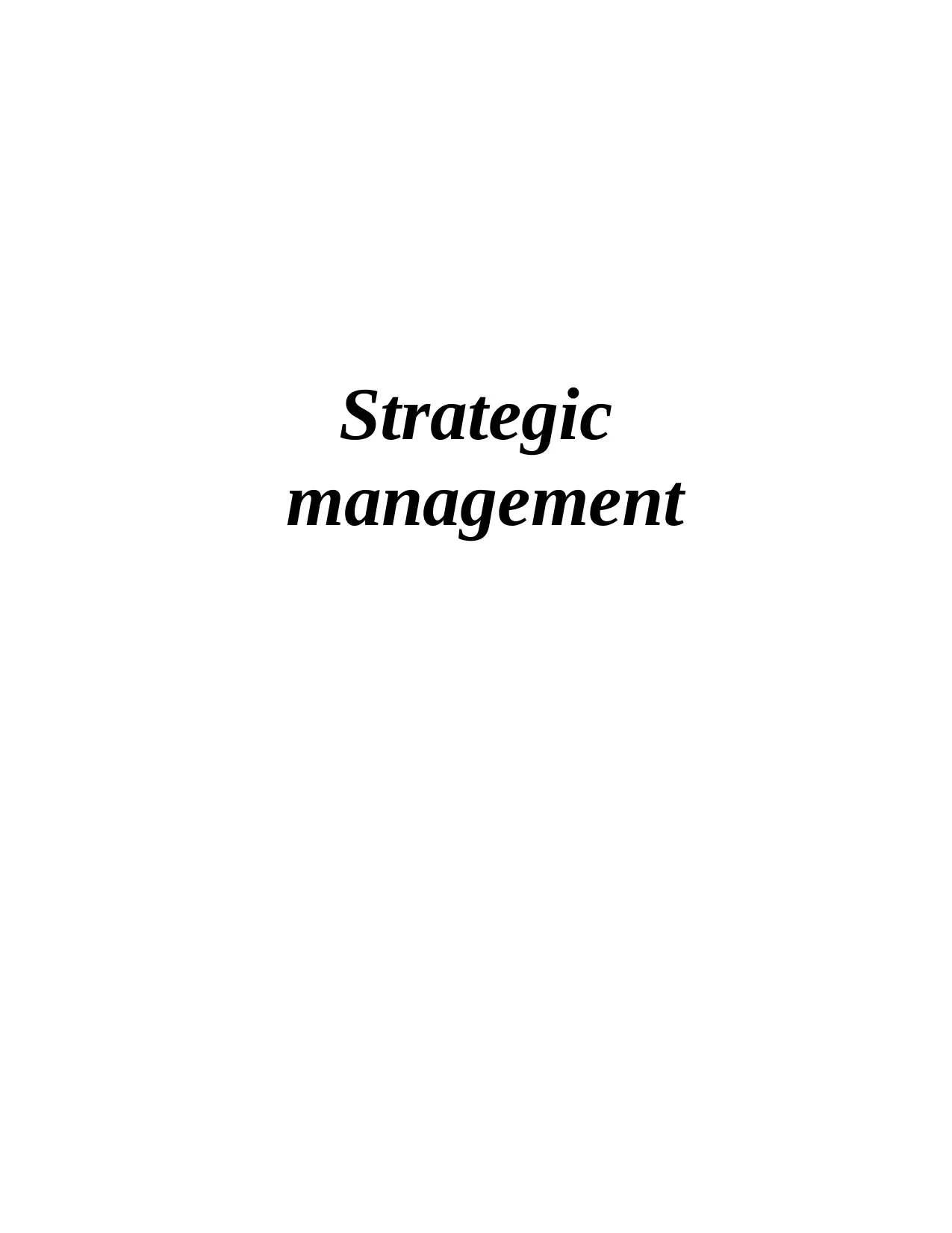
Strategic
management
management
Secure Best Marks with AI Grader
Need help grading? Try our AI Grader for instant feedback on your assignments.
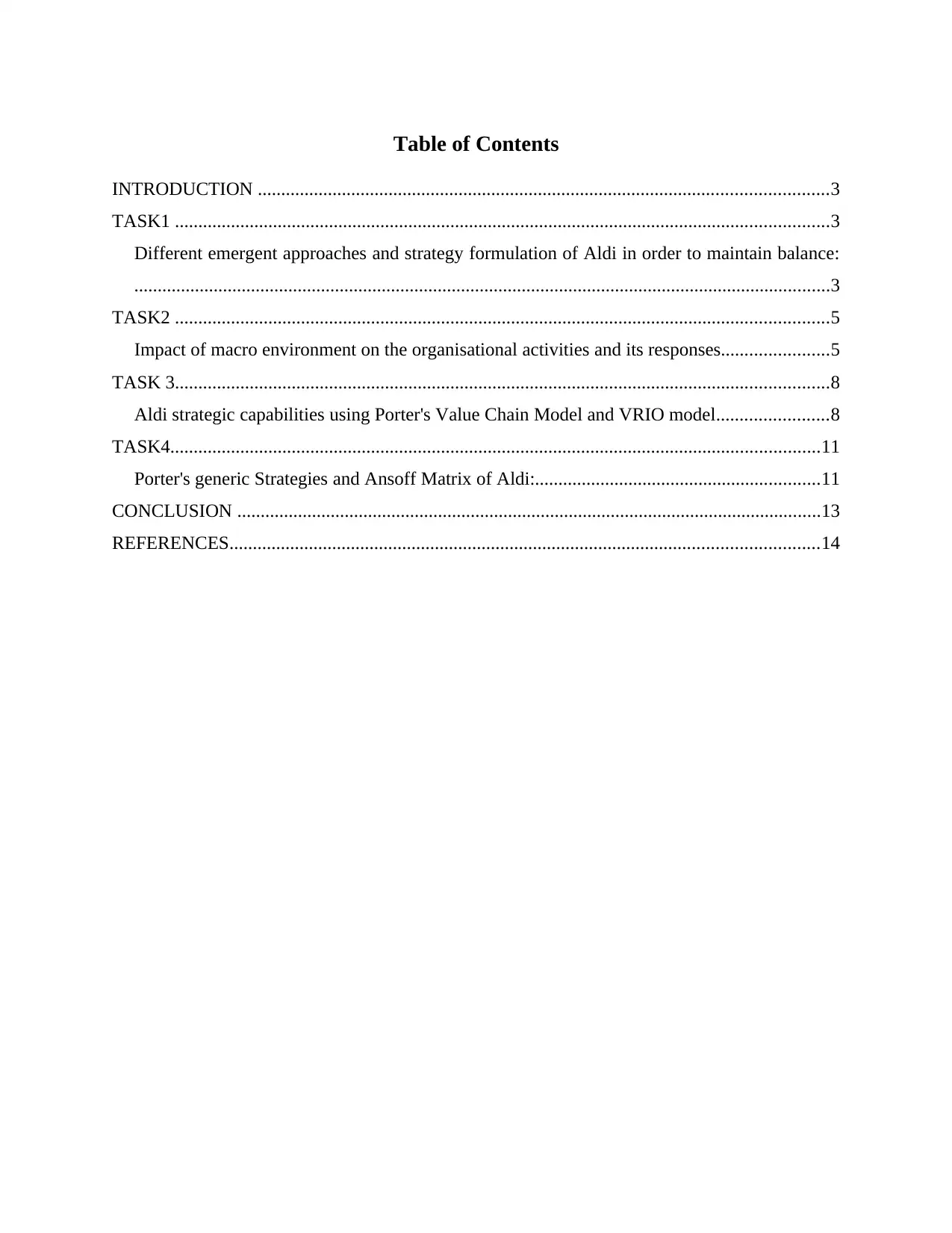
Table of Contents
INTRODUCTION ..........................................................................................................................3
TASK1 ............................................................................................................................................3
Different emergent approaches and strategy formulation of Aldi in order to maintain balance:
.....................................................................................................................................................3
TASK2 ............................................................................................................................................5
Impact of macro environment on the organisational activities and its responses.......................5
TASK 3............................................................................................................................................8
Aldi strategic capabilities using Porter's Value Chain Model and VRIO model........................8
TASK4...........................................................................................................................................11
Porter's generic Strategies and Ansoff Matrix of Aldi:.............................................................11
CONCLUSION .............................................................................................................................13
REFERENCES..............................................................................................................................14
INTRODUCTION ..........................................................................................................................3
TASK1 ............................................................................................................................................3
Different emergent approaches and strategy formulation of Aldi in order to maintain balance:
.....................................................................................................................................................3
TASK2 ............................................................................................................................................5
Impact of macro environment on the organisational activities and its responses.......................5
TASK 3............................................................................................................................................8
Aldi strategic capabilities using Porter's Value Chain Model and VRIO model........................8
TASK4...........................................................................................................................................11
Porter's generic Strategies and Ansoff Matrix of Aldi:.............................................................11
CONCLUSION .............................................................................................................................13
REFERENCES..............................................................................................................................14
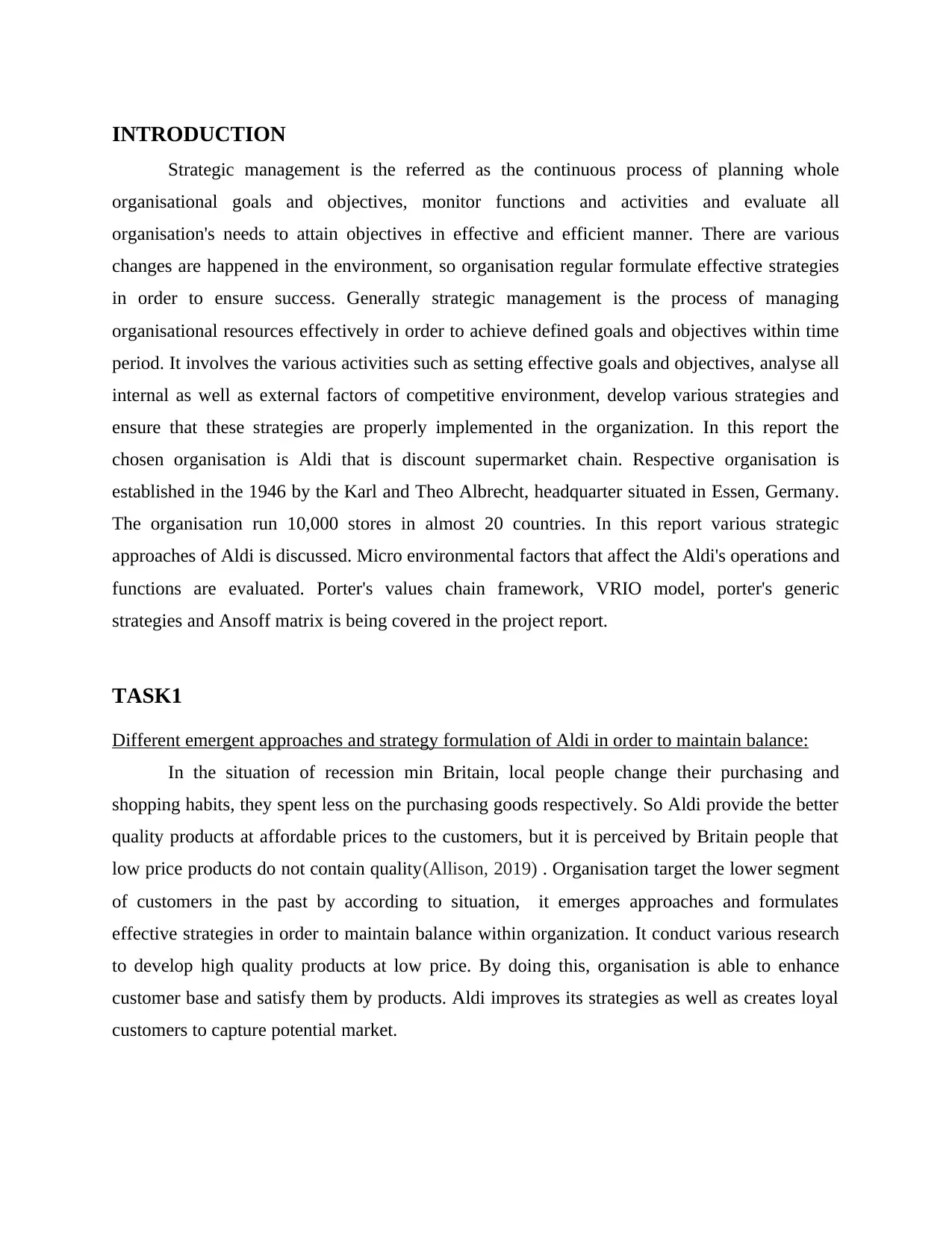
INTRODUCTION
Strategic management is the referred as the continuous process of planning whole
organisational goals and objectives, monitor functions and activities and evaluate all
organisation's needs to attain objectives in effective and efficient manner. There are various
changes are happened in the environment, so organisation regular formulate effective strategies
in order to ensure success. Generally strategic management is the process of managing
organisational resources effectively in order to achieve defined goals and objectives within time
period. It involves the various activities such as setting effective goals and objectives, analyse all
internal as well as external factors of competitive environment, develop various strategies and
ensure that these strategies are properly implemented in the organization. In this report the
chosen organisation is Aldi that is discount supermarket chain. Respective organisation is
established in the 1946 by the Karl and Theo Albrecht, headquarter situated in Essen, Germany.
The organisation run 10,000 stores in almost 20 countries. In this report various strategic
approaches of Aldi is discussed. Micro environmental factors that affect the Aldi's operations and
functions are evaluated. Porter's values chain framework, VRIO model, porter's generic
strategies and Ansoff matrix is being covered in the project report.
TASK1
Different emergent approaches and strategy formulation of Aldi in order to maintain balance:
In the situation of recession min Britain, local people change their purchasing and
shopping habits, they spent less on the purchasing goods respectively. So Aldi provide the better
quality products at affordable prices to the customers, but it is perceived by Britain people that
low price products do not contain quality(Allison, 2019) . Organisation target the lower segment
of customers in the past by according to situation, it emerges approaches and formulates
effective strategies in order to maintain balance within organization. It conduct various research
to develop high quality products at low price. By doing this, organisation is able to enhance
customer base and satisfy them by products. Aldi improves its strategies as well as creates loyal
customers to capture potential market.
Strategic management is the referred as the continuous process of planning whole
organisational goals and objectives, monitor functions and activities and evaluate all
organisation's needs to attain objectives in effective and efficient manner. There are various
changes are happened in the environment, so organisation regular formulate effective strategies
in order to ensure success. Generally strategic management is the process of managing
organisational resources effectively in order to achieve defined goals and objectives within time
period. It involves the various activities such as setting effective goals and objectives, analyse all
internal as well as external factors of competitive environment, develop various strategies and
ensure that these strategies are properly implemented in the organization. In this report the
chosen organisation is Aldi that is discount supermarket chain. Respective organisation is
established in the 1946 by the Karl and Theo Albrecht, headquarter situated in Essen, Germany.
The organisation run 10,000 stores in almost 20 countries. In this report various strategic
approaches of Aldi is discussed. Micro environmental factors that affect the Aldi's operations and
functions are evaluated. Porter's values chain framework, VRIO model, porter's generic
strategies and Ansoff matrix is being covered in the project report.
TASK1
Different emergent approaches and strategy formulation of Aldi in order to maintain balance:
In the situation of recession min Britain, local people change their purchasing and
shopping habits, they spent less on the purchasing goods respectively. So Aldi provide the better
quality products at affordable prices to the customers, but it is perceived by Britain people that
low price products do not contain quality(Allison, 2019) . Organisation target the lower segment
of customers in the past by according to situation, it emerges approaches and formulates
effective strategies in order to maintain balance within organization. It conduct various research
to develop high quality products at low price. By doing this, organisation is able to enhance
customer base and satisfy them by products. Aldi improves its strategies as well as creates loyal
customers to capture potential market.
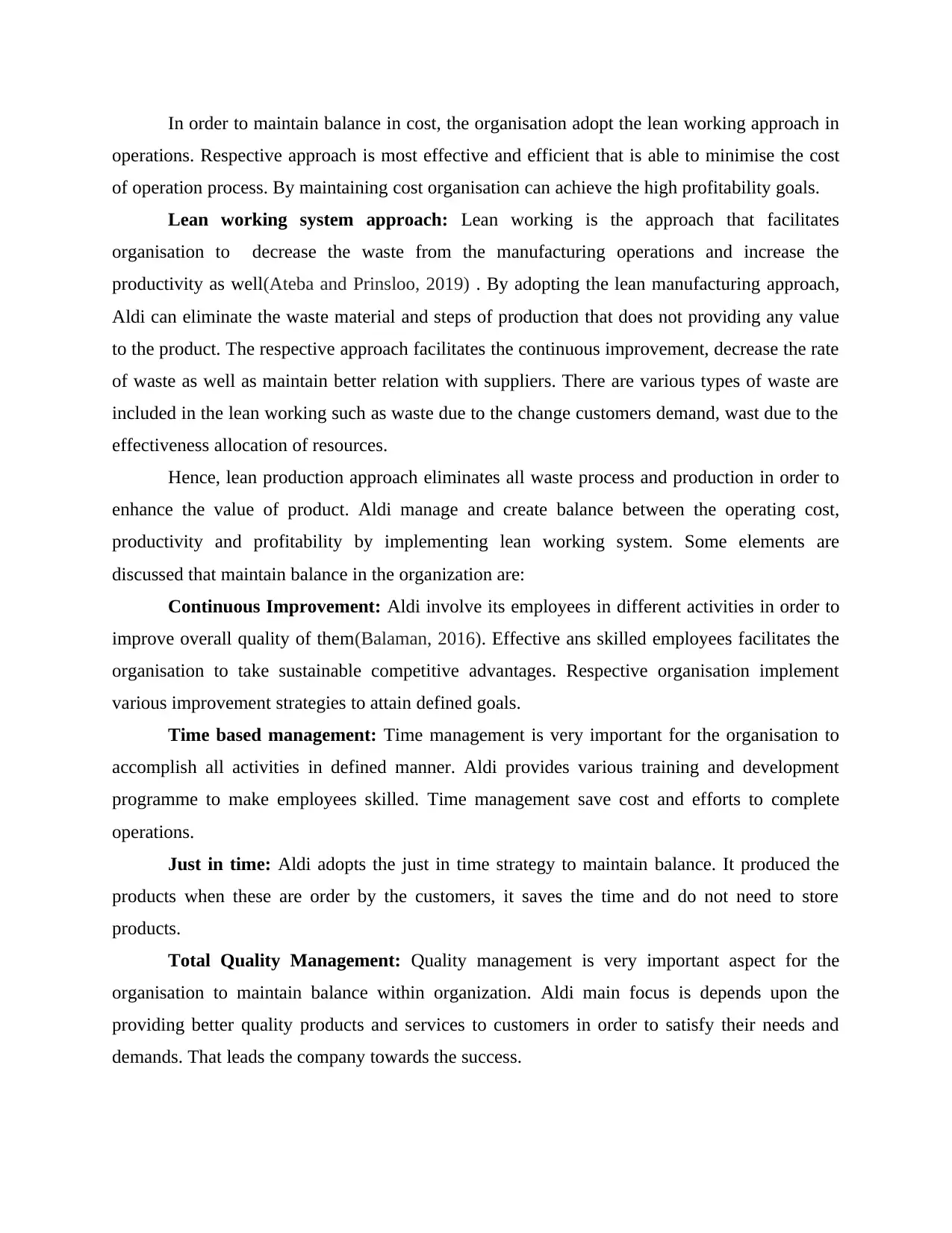
In order to maintain balance in cost, the organisation adopt the lean working approach in
operations. Respective approach is most effective and efficient that is able to minimise the cost
of operation process. By maintaining cost organisation can achieve the high profitability goals.
Lean working system approach: Lean working is the approach that facilitates
organisation to decrease the waste from the manufacturing operations and increase the
productivity as well(Ateba and Prinsloo, 2019) . By adopting the lean manufacturing approach,
Aldi can eliminate the waste material and steps of production that does not providing any value
to the product. The respective approach facilitates the continuous improvement, decrease the rate
of waste as well as maintain better relation with suppliers. There are various types of waste are
included in the lean working such as waste due to the change customers demand, wast due to the
effectiveness allocation of resources.
Hence, lean production approach eliminates all waste process and production in order to
enhance the value of product. Aldi manage and create balance between the operating cost,
productivity and profitability by implementing lean working system. Some elements are
discussed that maintain balance in the organization are:
Continuous Improvement: Aldi involve its employees in different activities in order to
improve overall quality of them(Balaman, 2016). Effective ans skilled employees facilitates the
organisation to take sustainable competitive advantages. Respective organisation implement
various improvement strategies to attain defined goals.
Time based management: Time management is very important for the organisation to
accomplish all activities in defined manner. Aldi provides various training and development
programme to make employees skilled. Time management save cost and efforts to complete
operations.
Just in time: Aldi adopts the just in time strategy to maintain balance. It produced the
products when these are order by the customers, it saves the time and do not need to store
products.
Total Quality Management: Quality management is very important aspect for the
organisation to maintain balance within organization. Aldi main focus is depends upon the
providing better quality products and services to customers in order to satisfy their needs and
demands. That leads the company towards the success.
operations. Respective approach is most effective and efficient that is able to minimise the cost
of operation process. By maintaining cost organisation can achieve the high profitability goals.
Lean working system approach: Lean working is the approach that facilitates
organisation to decrease the waste from the manufacturing operations and increase the
productivity as well(Ateba and Prinsloo, 2019) . By adopting the lean manufacturing approach,
Aldi can eliminate the waste material and steps of production that does not providing any value
to the product. The respective approach facilitates the continuous improvement, decrease the rate
of waste as well as maintain better relation with suppliers. There are various types of waste are
included in the lean working such as waste due to the change customers demand, wast due to the
effectiveness allocation of resources.
Hence, lean production approach eliminates all waste process and production in order to
enhance the value of product. Aldi manage and create balance between the operating cost,
productivity and profitability by implementing lean working system. Some elements are
discussed that maintain balance in the organization are:
Continuous Improvement: Aldi involve its employees in different activities in order to
improve overall quality of them(Balaman, 2016). Effective ans skilled employees facilitates the
organisation to take sustainable competitive advantages. Respective organisation implement
various improvement strategies to attain defined goals.
Time based management: Time management is very important for the organisation to
accomplish all activities in defined manner. Aldi provides various training and development
programme to make employees skilled. Time management save cost and efforts to complete
operations.
Just in time: Aldi adopts the just in time strategy to maintain balance. It produced the
products when these are order by the customers, it saves the time and do not need to store
products.
Total Quality Management: Quality management is very important aspect for the
organisation to maintain balance within organization. Aldi main focus is depends upon the
providing better quality products and services to customers in order to satisfy their needs and
demands. That leads the company towards the success.
Secure Best Marks with AI Grader
Need help grading? Try our AI Grader for instant feedback on your assignments.
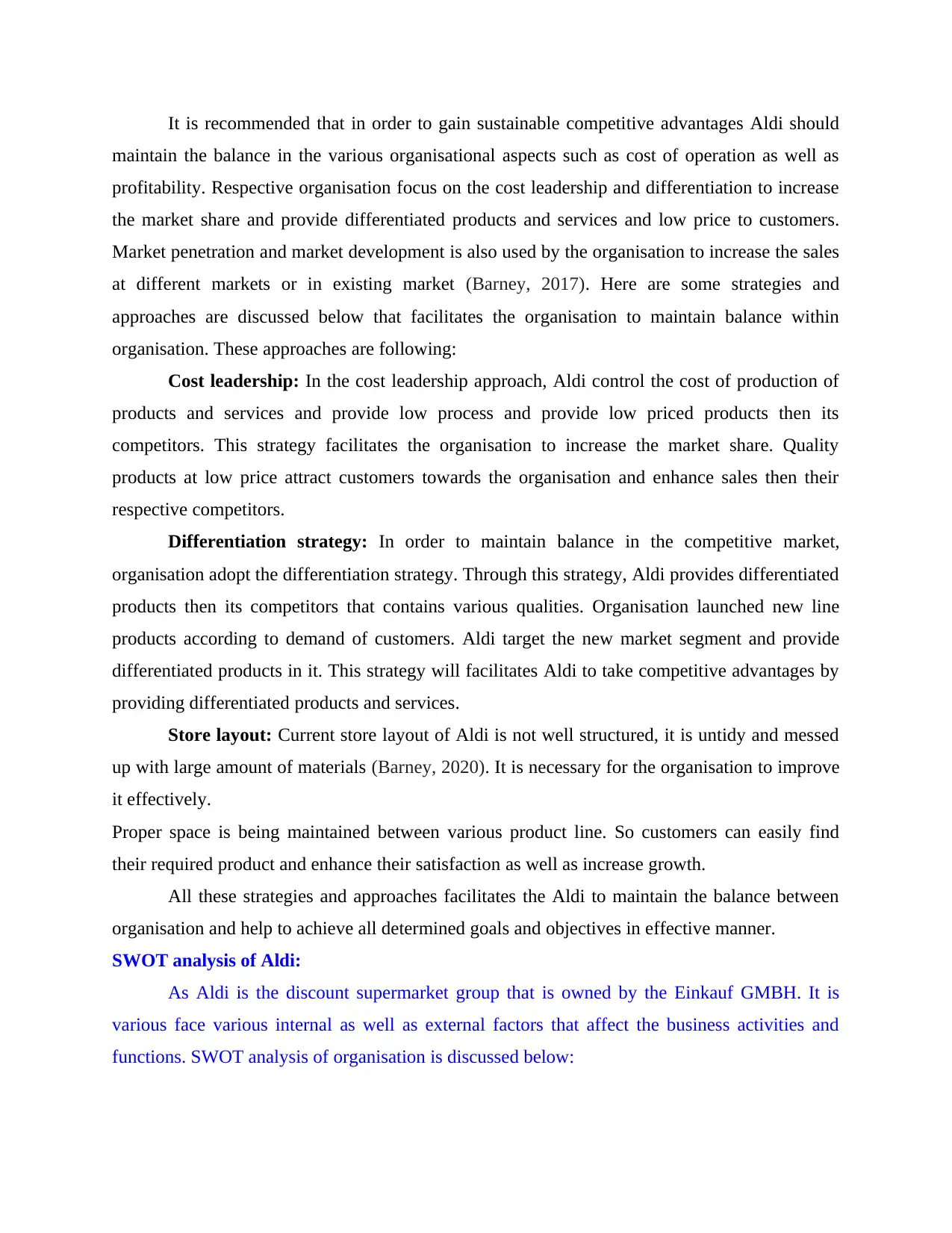
It is recommended that in order to gain sustainable competitive advantages Aldi should
maintain the balance in the various organisational aspects such as cost of operation as well as
profitability. Respective organisation focus on the cost leadership and differentiation to increase
the market share and provide differentiated products and services and low price to customers.
Market penetration and market development is also used by the organisation to increase the sales
at different markets or in existing market (Barney, 2017). Here are some strategies and
approaches are discussed below that facilitates the organisation to maintain balance within
organisation. These approaches are following:
Cost leadership: In the cost leadership approach, Aldi control the cost of production of
products and services and provide low process and provide low priced products then its
competitors. This strategy facilitates the organisation to increase the market share. Quality
products at low price attract customers towards the organisation and enhance sales then their
respective competitors.
Differentiation strategy: In order to maintain balance in the competitive market,
organisation adopt the differentiation strategy. Through this strategy, Aldi provides differentiated
products then its competitors that contains various qualities. Organisation launched new line
products according to demand of customers. Aldi target the new market segment and provide
differentiated products in it. This strategy will facilitates Aldi to take competitive advantages by
providing differentiated products and services.
Store layout: Current store layout of Aldi is not well structured, it is untidy and messed
up with large amount of materials (Barney, 2020). It is necessary for the organisation to improve
it effectively.
Proper space is being maintained between various product line. So customers can easily find
their required product and enhance their satisfaction as well as increase growth.
All these strategies and approaches facilitates the Aldi to maintain the balance between
organisation and help to achieve all determined goals and objectives in effective manner.
SWOT analysis of Aldi:
As Aldi is the discount supermarket group that is owned by the Einkauf GMBH. It is
various face various internal as well as external factors that affect the business activities and
functions. SWOT analysis of organisation is discussed below:
maintain the balance in the various organisational aspects such as cost of operation as well as
profitability. Respective organisation focus on the cost leadership and differentiation to increase
the market share and provide differentiated products and services and low price to customers.
Market penetration and market development is also used by the organisation to increase the sales
at different markets or in existing market (Barney, 2017). Here are some strategies and
approaches are discussed below that facilitates the organisation to maintain balance within
organisation. These approaches are following:
Cost leadership: In the cost leadership approach, Aldi control the cost of production of
products and services and provide low process and provide low priced products then its
competitors. This strategy facilitates the organisation to increase the market share. Quality
products at low price attract customers towards the organisation and enhance sales then their
respective competitors.
Differentiation strategy: In order to maintain balance in the competitive market,
organisation adopt the differentiation strategy. Through this strategy, Aldi provides differentiated
products then its competitors that contains various qualities. Organisation launched new line
products according to demand of customers. Aldi target the new market segment and provide
differentiated products in it. This strategy will facilitates Aldi to take competitive advantages by
providing differentiated products and services.
Store layout: Current store layout of Aldi is not well structured, it is untidy and messed
up with large amount of materials (Barney, 2020). It is necessary for the organisation to improve
it effectively.
Proper space is being maintained between various product line. So customers can easily find
their required product and enhance their satisfaction as well as increase growth.
All these strategies and approaches facilitates the Aldi to maintain the balance between
organisation and help to achieve all determined goals and objectives in effective manner.
SWOT analysis of Aldi:
As Aldi is the discount supermarket group that is owned by the Einkauf GMBH. It is
various face various internal as well as external factors that affect the business activities and
functions. SWOT analysis of organisation is discussed below:
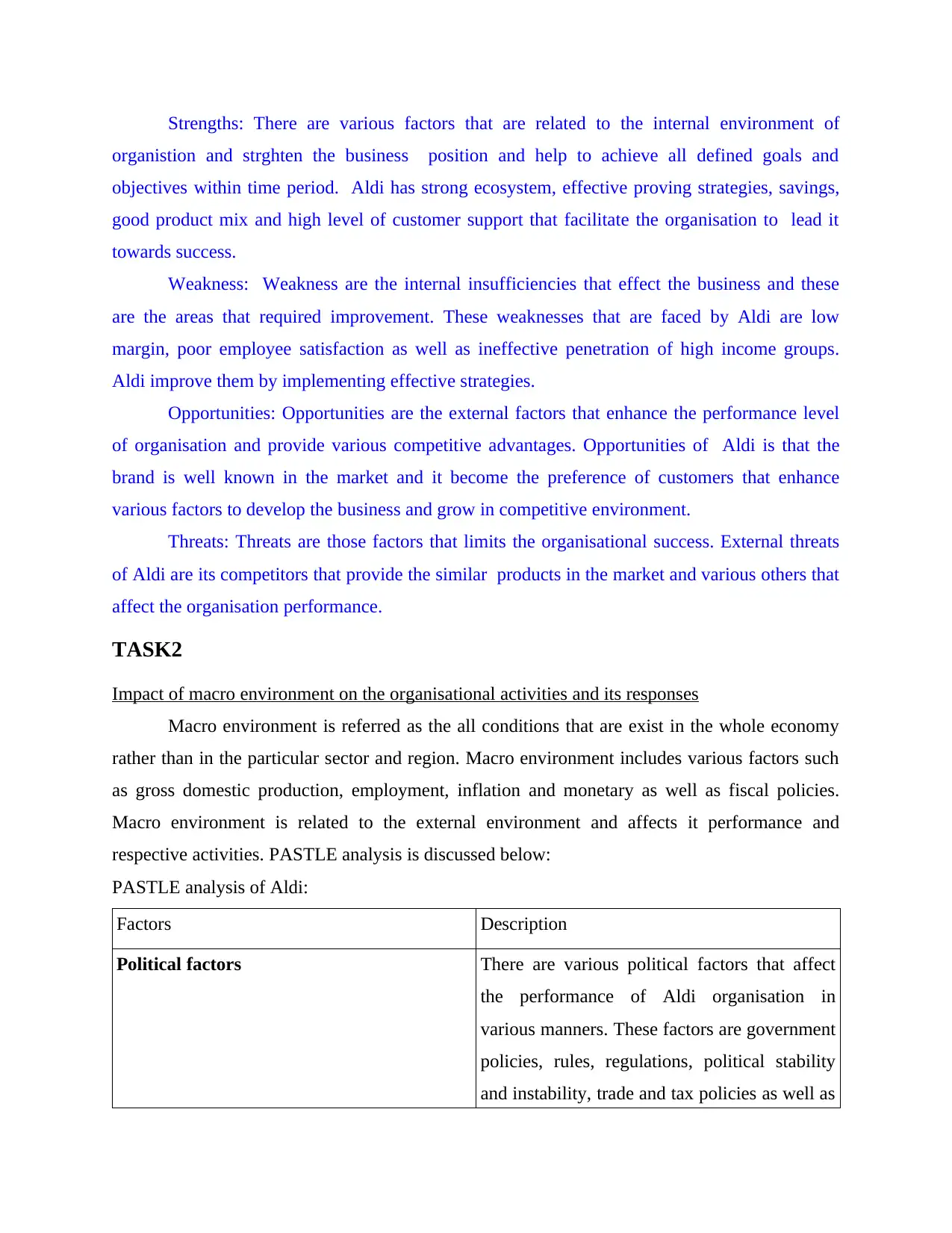
Strengths: There are various factors that are related to the internal environment of
organistion and strghten the business position and help to achieve all defined goals and
objectives within time period. Aldi has strong ecosystem, effective proving strategies, savings,
good product mix and high level of customer support that facilitate the organisation to lead it
towards success.
Weakness: Weakness are the internal insufficiencies that effect the business and these
are the areas that required improvement. These weaknesses that are faced by Aldi are low
margin, poor employee satisfaction as well as ineffective penetration of high income groups.
Aldi improve them by implementing effective strategies.
Opportunities: Opportunities are the external factors that enhance the performance level
of organisation and provide various competitive advantages. Opportunities of Aldi is that the
brand is well known in the market and it become the preference of customers that enhance
various factors to develop the business and grow in competitive environment.
Threats: Threats are those factors that limits the organisational success. External threats
of Aldi are its competitors that provide the similar products in the market and various others that
affect the organisation performance.
TASK2
Impact of macro environment on the organisational activities and its responses
Macro environment is referred as the all conditions that are exist in the whole economy
rather than in the particular sector and region. Macro environment includes various factors such
as gross domestic production, employment, inflation and monetary as well as fiscal policies.
Macro environment is related to the external environment and affects it performance and
respective activities. PASTLE analysis is discussed below:
PASTLE analysis of Aldi:
Factors Description
Political factors There are various political factors that affect
the performance of Aldi organisation in
various manners. These factors are government
policies, rules, regulations, political stability
and instability, trade and tax policies as well as
organistion and strghten the business position and help to achieve all defined goals and
objectives within time period. Aldi has strong ecosystem, effective proving strategies, savings,
good product mix and high level of customer support that facilitate the organisation to lead it
towards success.
Weakness: Weakness are the internal insufficiencies that effect the business and these
are the areas that required improvement. These weaknesses that are faced by Aldi are low
margin, poor employee satisfaction as well as ineffective penetration of high income groups.
Aldi improve them by implementing effective strategies.
Opportunities: Opportunities are the external factors that enhance the performance level
of organisation and provide various competitive advantages. Opportunities of Aldi is that the
brand is well known in the market and it become the preference of customers that enhance
various factors to develop the business and grow in competitive environment.
Threats: Threats are those factors that limits the organisational success. External threats
of Aldi are its competitors that provide the similar products in the market and various others that
affect the organisation performance.
TASK2
Impact of macro environment on the organisational activities and its responses
Macro environment is referred as the all conditions that are exist in the whole economy
rather than in the particular sector and region. Macro environment includes various factors such
as gross domestic production, employment, inflation and monetary as well as fiscal policies.
Macro environment is related to the external environment and affects it performance and
respective activities. PASTLE analysis is discussed below:
PASTLE analysis of Aldi:
Factors Description
Political factors There are various political factors that affect
the performance of Aldi organisation in
various manners. These factors are government
policies, rules, regulations, political stability
and instability, trade and tax policies as well as
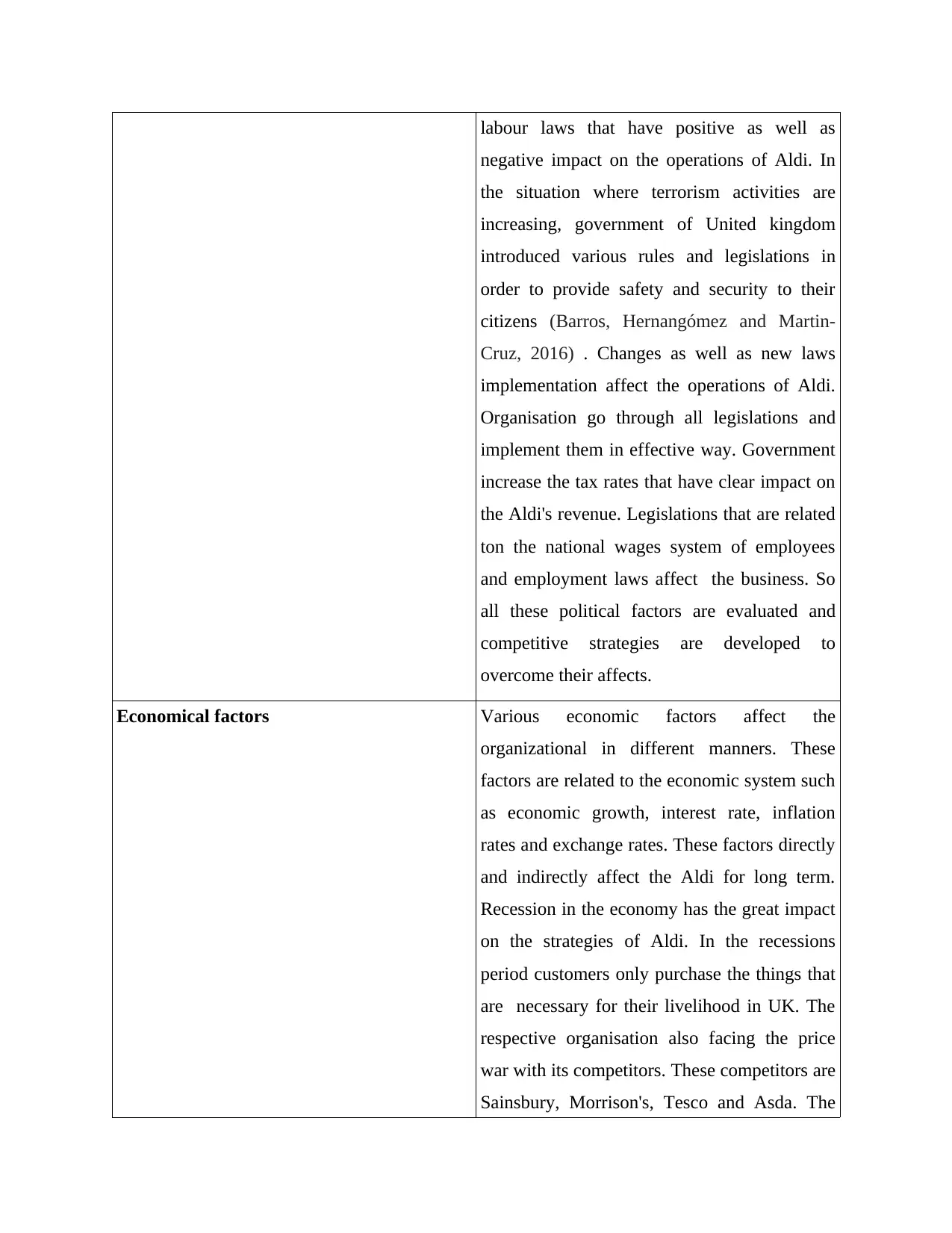
labour laws that have positive as well as
negative impact on the operations of Aldi. In
the situation where terrorism activities are
increasing, government of United kingdom
introduced various rules and legislations in
order to provide safety and security to their
citizens (Barros, Hernangómez and Martin-
Cruz, 2016) . Changes as well as new laws
implementation affect the operations of Aldi.
Organisation go through all legislations and
implement them in effective way. Government
increase the tax rates that have clear impact on
the Aldi's revenue. Legislations that are related
ton the national wages system of employees
and employment laws affect the business. So
all these political factors are evaluated and
competitive strategies are developed to
overcome their affects.
Economical factors Various economic factors affect the
organizational in different manners. These
factors are related to the economic system such
as economic growth, interest rate, inflation
rates and exchange rates. These factors directly
and indirectly affect the Aldi for long term.
Recession in the economy has the great impact
on the strategies of Aldi. In the recessions
period customers only purchase the things that
are necessary for their livelihood in UK. The
respective organisation also facing the price
war with its competitors. These competitors are
Sainsbury, Morrison's, Tesco and Asda. The
negative impact on the operations of Aldi. In
the situation where terrorism activities are
increasing, government of United kingdom
introduced various rules and legislations in
order to provide safety and security to their
citizens (Barros, Hernangómez and Martin-
Cruz, 2016) . Changes as well as new laws
implementation affect the operations of Aldi.
Organisation go through all legislations and
implement them in effective way. Government
increase the tax rates that have clear impact on
the Aldi's revenue. Legislations that are related
ton the national wages system of employees
and employment laws affect the business. So
all these political factors are evaluated and
competitive strategies are developed to
overcome their affects.
Economical factors Various economic factors affect the
organizational in different manners. These
factors are related to the economic system such
as economic growth, interest rate, inflation
rates and exchange rates. These factors directly
and indirectly affect the Aldi for long term.
Recession in the economy has the great impact
on the strategies of Aldi. In the recessions
period customers only purchase the things that
are necessary for their livelihood in UK. The
respective organisation also facing the price
war with its competitors. These competitors are
Sainsbury, Morrison's, Tesco and Asda. The
Paraphrase This Document
Need a fresh take? Get an instant paraphrase of this document with our AI Paraphraser
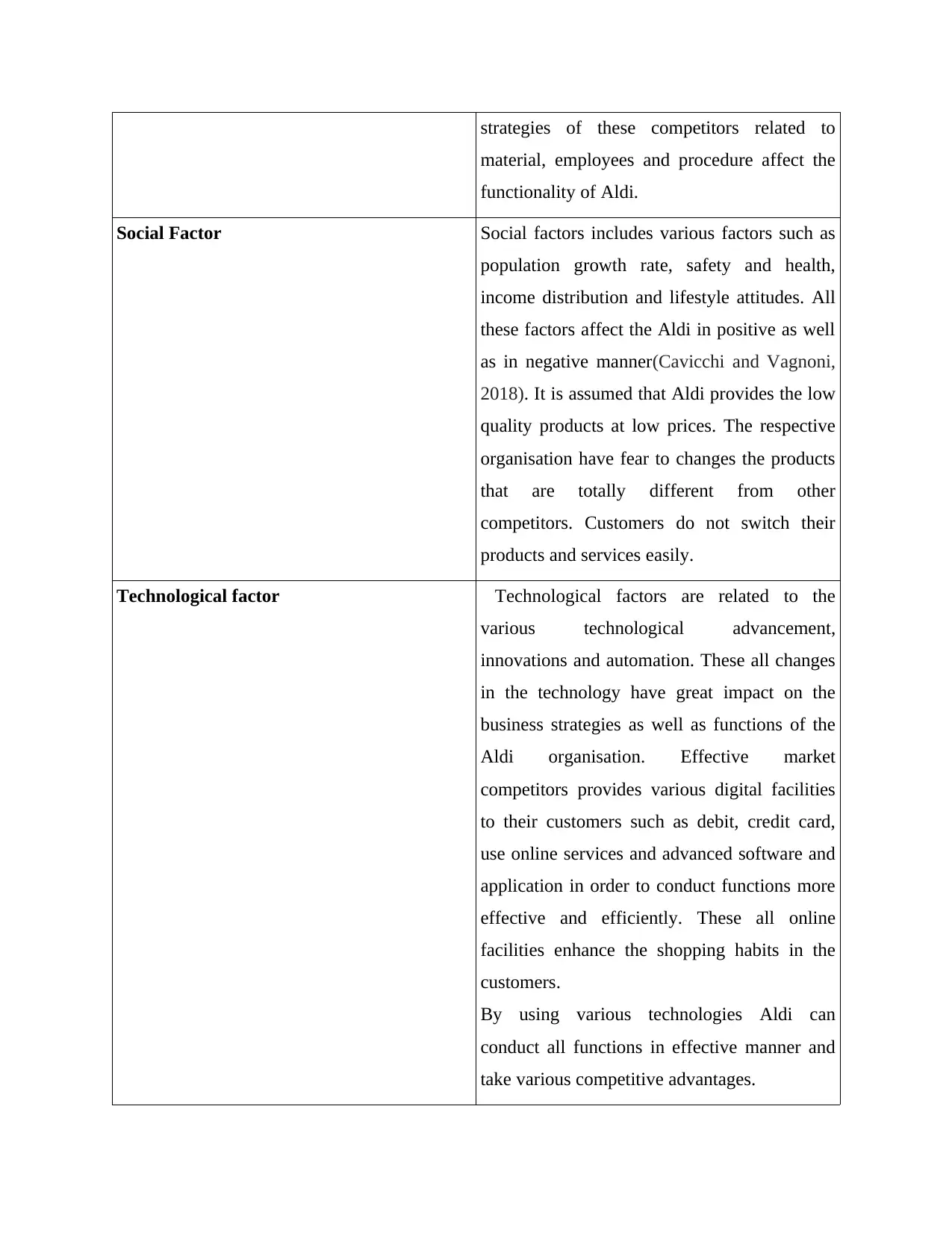
strategies of these competitors related to
material, employees and procedure affect the
functionality of Aldi.
Social Factor Social factors includes various factors such as
population growth rate, safety and health,
income distribution and lifestyle attitudes. All
these factors affect the Aldi in positive as well
as in negative manner(Cavicchi and Vagnoni,
2018). It is assumed that Aldi provides the low
quality products at low prices. The respective
organisation have fear to changes the products
that are totally different from other
competitors. Customers do not switch their
products and services easily.
Technological factor Technological factors are related to the
various technological advancement,
innovations and automation. These all changes
in the technology have great impact on the
business strategies as well as functions of the
Aldi organisation. Effective market
competitors provides various digital facilities
to their customers such as debit, credit card,
use online services and advanced software and
application in order to conduct functions more
effective and efficiently. These all online
facilities enhance the shopping habits in the
customers.
By using various technologies Aldi can
conduct all functions in effective manner and
take various competitive advantages.
material, employees and procedure affect the
functionality of Aldi.
Social Factor Social factors includes various factors such as
population growth rate, safety and health,
income distribution and lifestyle attitudes. All
these factors affect the Aldi in positive as well
as in negative manner(Cavicchi and Vagnoni,
2018). It is assumed that Aldi provides the low
quality products at low prices. The respective
organisation have fear to changes the products
that are totally different from other
competitors. Customers do not switch their
products and services easily.
Technological factor Technological factors are related to the
various technological advancement,
innovations and automation. These all changes
in the technology have great impact on the
business strategies as well as functions of the
Aldi organisation. Effective market
competitors provides various digital facilities
to their customers such as debit, credit card,
use online services and advanced software and
application in order to conduct functions more
effective and efficiently. These all online
facilities enhance the shopping habits in the
customers.
By using various technologies Aldi can
conduct all functions in effective manner and
take various competitive advantages.
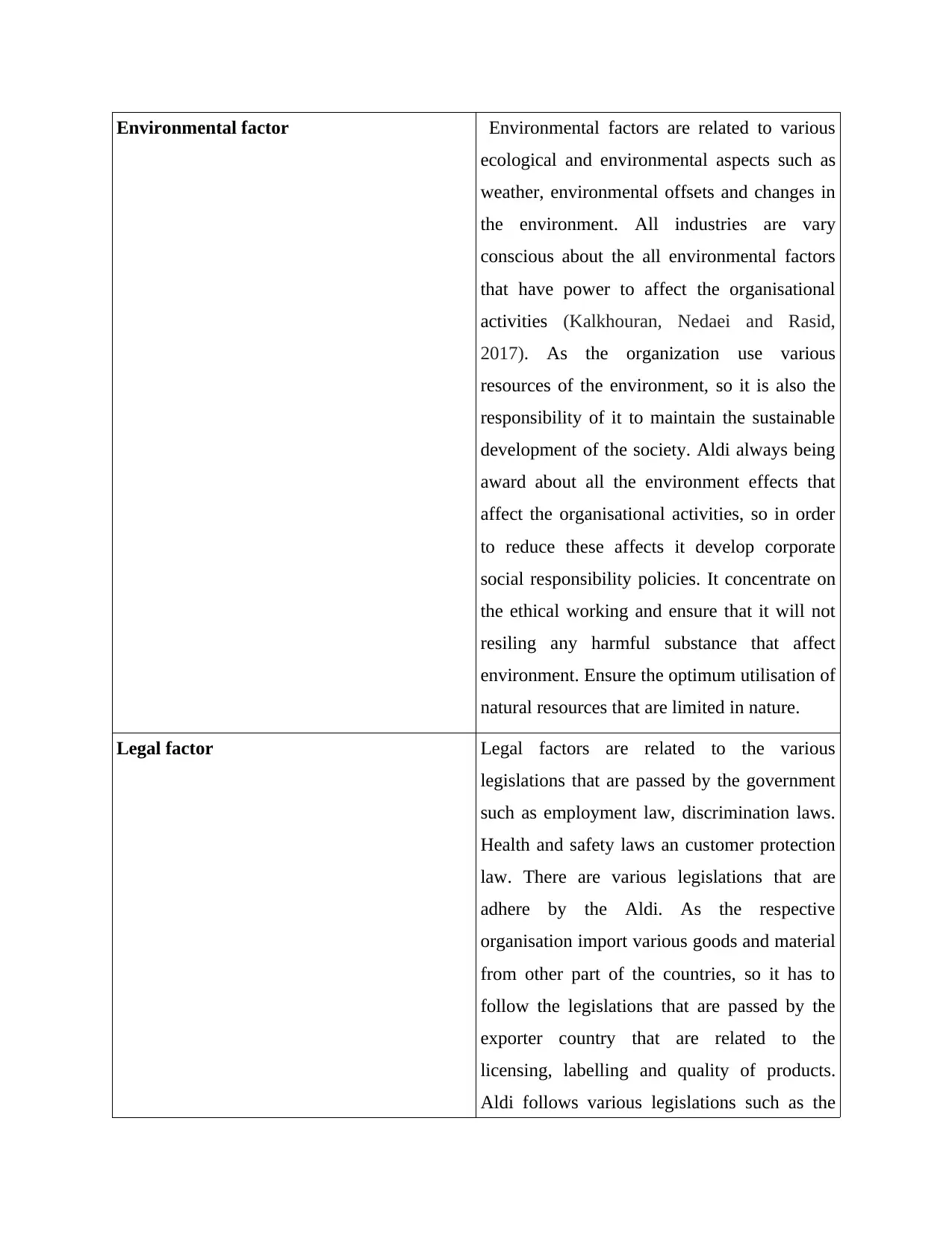
Environmental factor Environmental factors are related to various
ecological and environmental aspects such as
weather, environmental offsets and changes in
the environment. All industries are vary
conscious about the all environmental factors
that have power to affect the organisational
activities (Kalkhouran, Nedaei and Rasid,
2017). As the organization use various
resources of the environment, so it is also the
responsibility of it to maintain the sustainable
development of the society. Aldi always being
award about all the environment effects that
affect the organisational activities, so in order
to reduce these affects it develop corporate
social responsibility policies. It concentrate on
the ethical working and ensure that it will not
resiling any harmful substance that affect
environment. Ensure the optimum utilisation of
natural resources that are limited in nature.
Legal factor Legal factors are related to the various
legislations that are passed by the government
such as employment law, discrimination laws.
Health and safety laws an customer protection
law. There are various legislations that are
adhere by the Aldi. As the respective
organisation import various goods and material
from other part of the countries, so it has to
follow the legislations that are passed by the
exporter country that are related to the
licensing, labelling and quality of products.
Aldi follows various legislations such as the
ecological and environmental aspects such as
weather, environmental offsets and changes in
the environment. All industries are vary
conscious about the all environmental factors
that have power to affect the organisational
activities (Kalkhouran, Nedaei and Rasid,
2017). As the organization use various
resources of the environment, so it is also the
responsibility of it to maintain the sustainable
development of the society. Aldi always being
award about all the environment effects that
affect the organisational activities, so in order
to reduce these affects it develop corporate
social responsibility policies. It concentrate on
the ethical working and ensure that it will not
resiling any harmful substance that affect
environment. Ensure the optimum utilisation of
natural resources that are limited in nature.
Legal factor Legal factors are related to the various
legislations that are passed by the government
such as employment law, discrimination laws.
Health and safety laws an customer protection
law. There are various legislations that are
adhere by the Aldi. As the respective
organisation import various goods and material
from other part of the countries, so it has to
follow the legislations that are passed by the
exporter country that are related to the
licensing, labelling and quality of products.
Aldi follows various legislations such as the
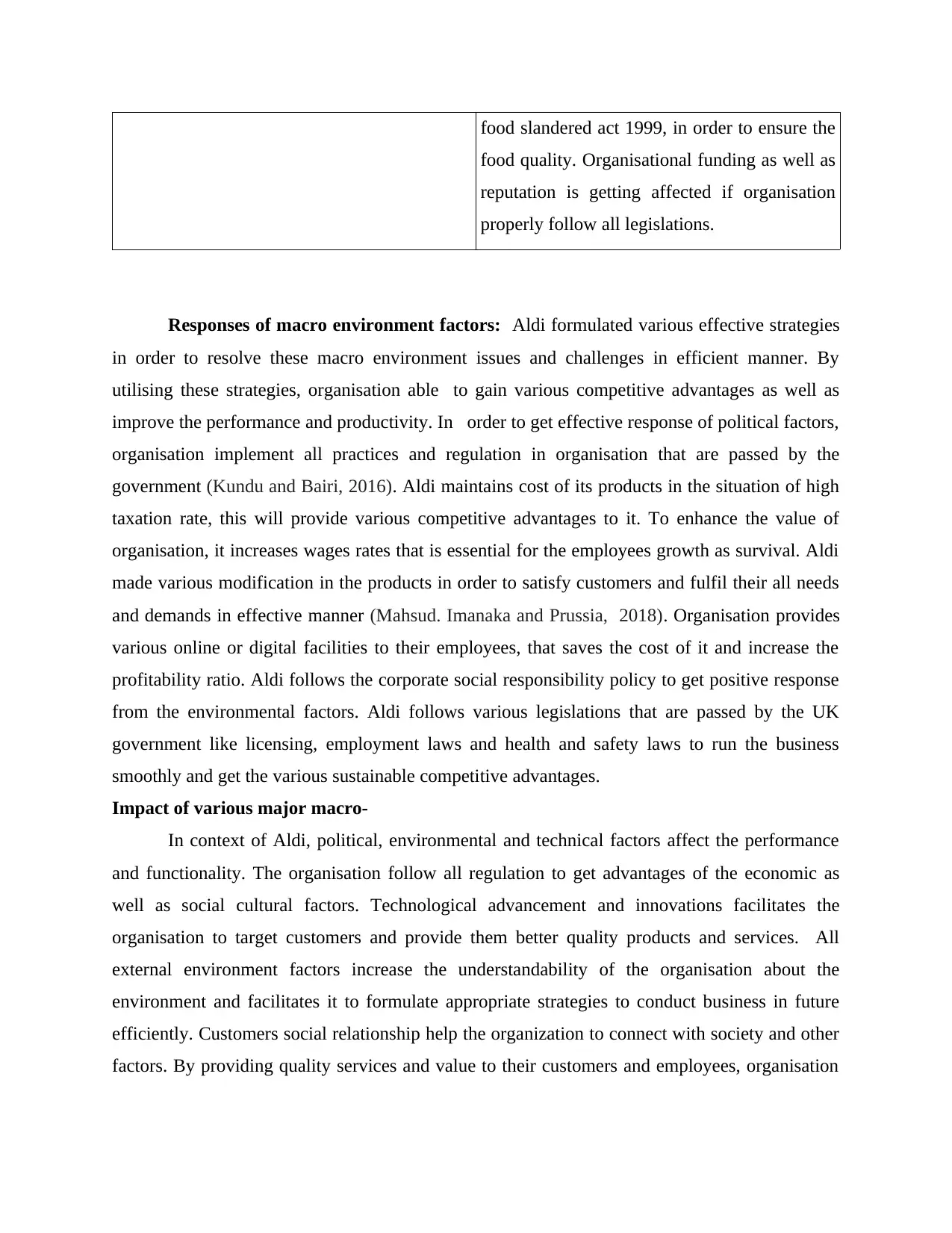
food slandered act 1999, in order to ensure the
food quality. Organisational funding as well as
reputation is getting affected if organisation
properly follow all legislations.
Responses of macro environment factors: Aldi formulated various effective strategies
in order to resolve these macro environment issues and challenges in efficient manner. By
utilising these strategies, organisation able to gain various competitive advantages as well as
improve the performance and productivity. In order to get effective response of political factors,
organisation implement all practices and regulation in organisation that are passed by the
government (Kundu and Bairi, 2016). Aldi maintains cost of its products in the situation of high
taxation rate, this will provide various competitive advantages to it. To enhance the value of
organisation, it increases wages rates that is essential for the employees growth as survival. Aldi
made various modification in the products in order to satisfy customers and fulfil their all needs
and demands in effective manner (Mahsud. Imanaka and Prussia, 2018). Organisation provides
various online or digital facilities to their employees, that saves the cost of it and increase the
profitability ratio. Aldi follows the corporate social responsibility policy to get positive response
from the environmental factors. Aldi follows various legislations that are passed by the UK
government like licensing, employment laws and health and safety laws to run the business
smoothly and get the various sustainable competitive advantages.
Impact of various major macro-
In context of Aldi, political, environmental and technical factors affect the performance
and functionality. The organisation follow all regulation to get advantages of the economic as
well as social cultural factors. Technological advancement and innovations facilitates the
organisation to target customers and provide them better quality products and services. All
external environment factors increase the understandability of the organisation about the
environment and facilitates it to formulate appropriate strategies to conduct business in future
efficiently. Customers social relationship help the organization to connect with society and other
factors. By providing quality services and value to their customers and employees, organisation
food quality. Organisational funding as well as
reputation is getting affected if organisation
properly follow all legislations.
Responses of macro environment factors: Aldi formulated various effective strategies
in order to resolve these macro environment issues and challenges in efficient manner. By
utilising these strategies, organisation able to gain various competitive advantages as well as
improve the performance and productivity. In order to get effective response of political factors,
organisation implement all practices and regulation in organisation that are passed by the
government (Kundu and Bairi, 2016). Aldi maintains cost of its products in the situation of high
taxation rate, this will provide various competitive advantages to it. To enhance the value of
organisation, it increases wages rates that is essential for the employees growth as survival. Aldi
made various modification in the products in order to satisfy customers and fulfil their all needs
and demands in effective manner (Mahsud. Imanaka and Prussia, 2018). Organisation provides
various online or digital facilities to their employees, that saves the cost of it and increase the
profitability ratio. Aldi follows the corporate social responsibility policy to get positive response
from the environmental factors. Aldi follows various legislations that are passed by the UK
government like licensing, employment laws and health and safety laws to run the business
smoothly and get the various sustainable competitive advantages.
Impact of various major macro-
In context of Aldi, political, environmental and technical factors affect the performance
and functionality. The organisation follow all regulation to get advantages of the economic as
well as social cultural factors. Technological advancement and innovations facilitates the
organisation to target customers and provide them better quality products and services. All
external environment factors increase the understandability of the organisation about the
environment and facilitates it to formulate appropriate strategies to conduct business in future
efficiently. Customers social relationship help the organization to connect with society and other
factors. By providing quality services and value to their customers and employees, organisation
Secure Best Marks with AI Grader
Need help grading? Try our AI Grader for instant feedback on your assignments.
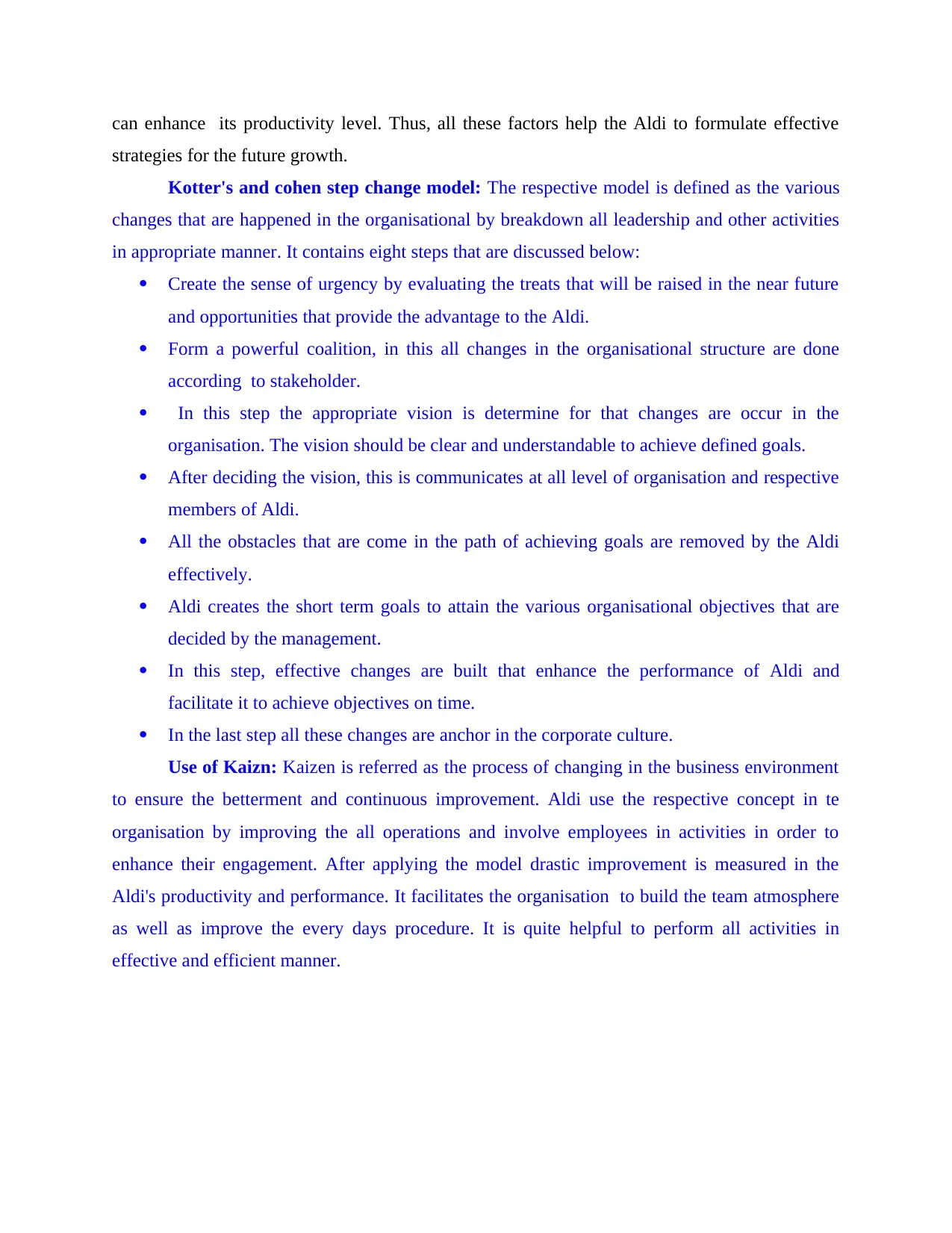
can enhance its productivity level. Thus, all these factors help the Aldi to formulate effective
strategies for the future growth.
Kotter's and cohen step change model: The respective model is defined as the various
changes that are happened in the organisational by breakdown all leadership and other activities
in appropriate manner. It contains eight steps that are discussed below:
Create the sense of urgency by evaluating the treats that will be raised in the near future
and opportunities that provide the advantage to the Aldi.
Form a powerful coalition, in this all changes in the organisational structure are done
according to stakeholder.
In this step the appropriate vision is determine for that changes are occur in the
organisation. The vision should be clear and understandable to achieve defined goals.
After deciding the vision, this is communicates at all level of organisation and respective
members of Aldi.
All the obstacles that are come in the path of achieving goals are removed by the Aldi
effectively.
Aldi creates the short term goals to attain the various organisational objectives that are
decided by the management.
In this step, effective changes are built that enhance the performance of Aldi and
facilitate it to achieve objectives on time.
In the last step all these changes are anchor in the corporate culture.
Use of Kaizn: Kaizen is referred as the process of changing in the business environment
to ensure the betterment and continuous improvement. Aldi use the respective concept in te
organisation by improving the all operations and involve employees in activities in order to
enhance their engagement. After applying the model drastic improvement is measured in the
Aldi's productivity and performance. It facilitates the organisation to build the team atmosphere
as well as improve the every days procedure. It is quite helpful to perform all activities in
effective and efficient manner.
strategies for the future growth.
Kotter's and cohen step change model: The respective model is defined as the various
changes that are happened in the organisational by breakdown all leadership and other activities
in appropriate manner. It contains eight steps that are discussed below:
Create the sense of urgency by evaluating the treats that will be raised in the near future
and opportunities that provide the advantage to the Aldi.
Form a powerful coalition, in this all changes in the organisational structure are done
according to stakeholder.
In this step the appropriate vision is determine for that changes are occur in the
organisation. The vision should be clear and understandable to achieve defined goals.
After deciding the vision, this is communicates at all level of organisation and respective
members of Aldi.
All the obstacles that are come in the path of achieving goals are removed by the Aldi
effectively.
Aldi creates the short term goals to attain the various organisational objectives that are
decided by the management.
In this step, effective changes are built that enhance the performance of Aldi and
facilitate it to achieve objectives on time.
In the last step all these changes are anchor in the corporate culture.
Use of Kaizn: Kaizen is referred as the process of changing in the business environment
to ensure the betterment and continuous improvement. Aldi use the respective concept in te
organisation by improving the all operations and involve employees in activities in order to
enhance their engagement. After applying the model drastic improvement is measured in the
Aldi's productivity and performance. It facilitates the organisation to build the team atmosphere
as well as improve the every days procedure. It is quite helpful to perform all activities in
effective and efficient manner.
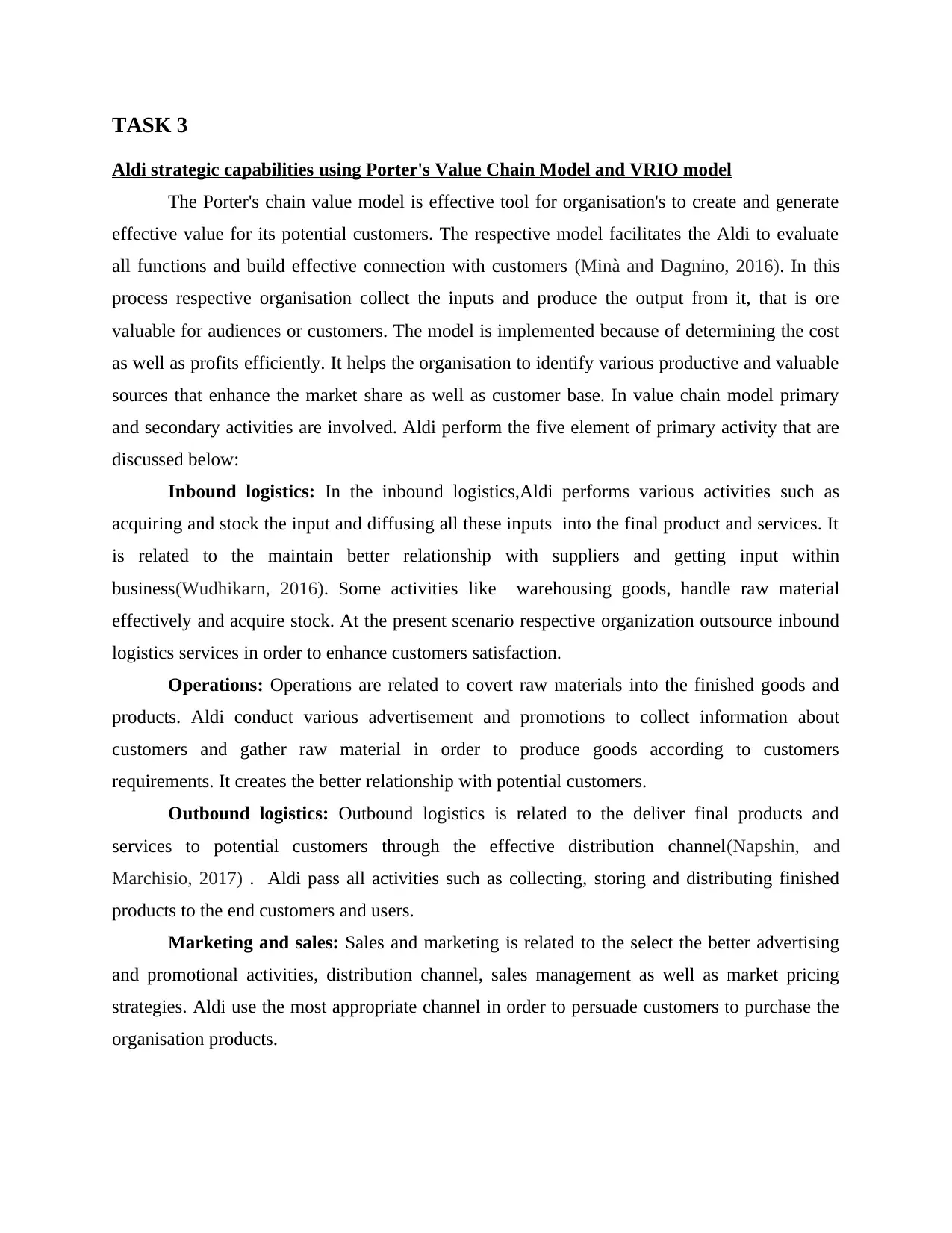
TASK 3
Aldi strategic capabilities using Porter's Value Chain Model and VRIO model
The Porter's chain value model is effective tool for organisation's to create and generate
effective value for its potential customers. The respective model facilitates the Aldi to evaluate
all functions and build effective connection with customers (Minà and Dagnino, 2016). In this
process respective organisation collect the inputs and produce the output from it, that is ore
valuable for audiences or customers. The model is implemented because of determining the cost
as well as profits efficiently. It helps the organisation to identify various productive and valuable
sources that enhance the market share as well as customer base. In value chain model primary
and secondary activities are involved. Aldi perform the five element of primary activity that are
discussed below:
Inbound logistics: In the inbound logistics,Aldi performs various activities such as
acquiring and stock the input and diffusing all these inputs into the final product and services. It
is related to the maintain better relationship with suppliers and getting input within
business(Wudhikarn, 2016). Some activities like warehousing goods, handle raw material
effectively and acquire stock. At the present scenario respective organization outsource inbound
logistics services in order to enhance customers satisfaction.
Operations: Operations are related to covert raw materials into the finished goods and
products. Aldi conduct various advertisement and promotions to collect information about
customers and gather raw material in order to produce goods according to customers
requirements. It creates the better relationship with potential customers.
Outbound logistics: Outbound logistics is related to the deliver final products and
services to potential customers through the effective distribution channel(Napshin, and
Marchisio, 2017) . Aldi pass all activities such as collecting, storing and distributing finished
products to the end customers and users.
Marketing and sales: Sales and marketing is related to the select the better advertising
and promotional activities, distribution channel, sales management as well as market pricing
strategies. Aldi use the most appropriate channel in order to persuade customers to purchase the
organisation products.
Aldi strategic capabilities using Porter's Value Chain Model and VRIO model
The Porter's chain value model is effective tool for organisation's to create and generate
effective value for its potential customers. The respective model facilitates the Aldi to evaluate
all functions and build effective connection with customers (Minà and Dagnino, 2016). In this
process respective organisation collect the inputs and produce the output from it, that is ore
valuable for audiences or customers. The model is implemented because of determining the cost
as well as profits efficiently. It helps the organisation to identify various productive and valuable
sources that enhance the market share as well as customer base. In value chain model primary
and secondary activities are involved. Aldi perform the five element of primary activity that are
discussed below:
Inbound logistics: In the inbound logistics,Aldi performs various activities such as
acquiring and stock the input and diffusing all these inputs into the final product and services. It
is related to the maintain better relationship with suppliers and getting input within
business(Wudhikarn, 2016). Some activities like warehousing goods, handle raw material
effectively and acquire stock. At the present scenario respective organization outsource inbound
logistics services in order to enhance customers satisfaction.
Operations: Operations are related to covert raw materials into the finished goods and
products. Aldi conduct various advertisement and promotions to collect information about
customers and gather raw material in order to produce goods according to customers
requirements. It creates the better relationship with potential customers.
Outbound logistics: Outbound logistics is related to the deliver final products and
services to potential customers through the effective distribution channel(Napshin, and
Marchisio, 2017) . Aldi pass all activities such as collecting, storing and distributing finished
products to the end customers and users.
Marketing and sales: Sales and marketing is related to the select the better advertising
and promotional activities, distribution channel, sales management as well as market pricing
strategies. Aldi use the most appropriate channel in order to persuade customers to purchase the
organisation products.
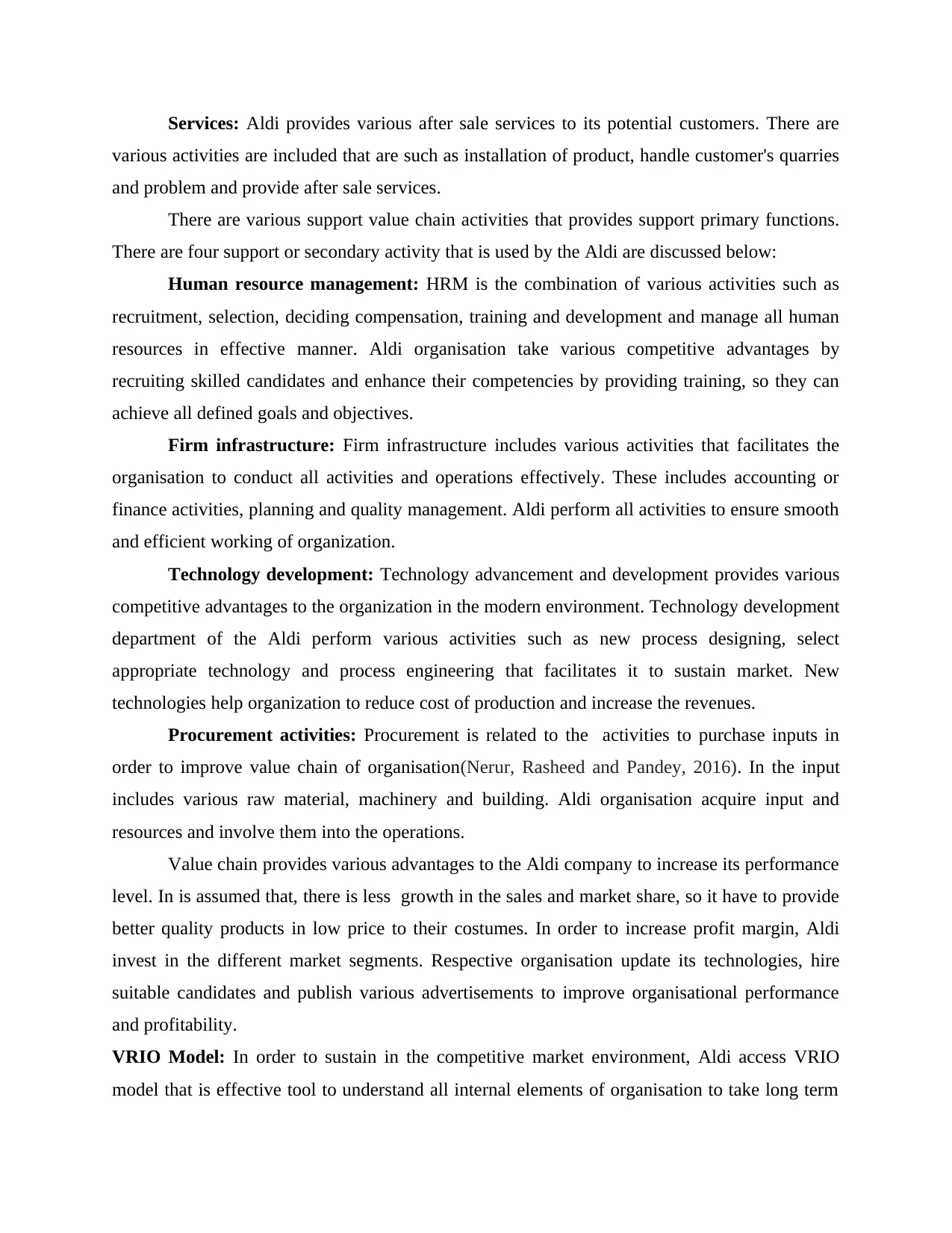
Services: Aldi provides various after sale services to its potential customers. There are
various activities are included that are such as installation of product, handle customer's quarries
and problem and provide after sale services.
There are various support value chain activities that provides support primary functions.
There are four support or secondary activity that is used by the Aldi are discussed below:
Human resource management: HRM is the combination of various activities such as
recruitment, selection, deciding compensation, training and development and manage all human
resources in effective manner. Aldi organisation take various competitive advantages by
recruiting skilled candidates and enhance their competencies by providing training, so they can
achieve all defined goals and objectives.
Firm infrastructure: Firm infrastructure includes various activities that facilitates the
organisation to conduct all activities and operations effectively. These includes accounting or
finance activities, planning and quality management. Aldi perform all activities to ensure smooth
and efficient working of organization.
Technology development: Technology advancement and development provides various
competitive advantages to the organization in the modern environment. Technology development
department of the Aldi perform various activities such as new process designing, select
appropriate technology and process engineering that facilitates it to sustain market. New
technologies help organization to reduce cost of production and increase the revenues.
Procurement activities: Procurement is related to the activities to purchase inputs in
order to improve value chain of organisation(Nerur, Rasheed and Pandey, 2016). In the input
includes various raw material, machinery and building. Aldi organisation acquire input and
resources and involve them into the operations.
Value chain provides various advantages to the Aldi company to increase its performance
level. In is assumed that, there is less growth in the sales and market share, so it have to provide
better quality products in low price to their costumes. In order to increase profit margin, Aldi
invest in the different market segments. Respective organisation update its technologies, hire
suitable candidates and publish various advertisements to improve organisational performance
and profitability.
VRIO Model: In order to sustain in the competitive market environment, Aldi access VRIO
model that is effective tool to understand all internal elements of organisation to take long term
various activities are included that are such as installation of product, handle customer's quarries
and problem and provide after sale services.
There are various support value chain activities that provides support primary functions.
There are four support or secondary activity that is used by the Aldi are discussed below:
Human resource management: HRM is the combination of various activities such as
recruitment, selection, deciding compensation, training and development and manage all human
resources in effective manner. Aldi organisation take various competitive advantages by
recruiting skilled candidates and enhance their competencies by providing training, so they can
achieve all defined goals and objectives.
Firm infrastructure: Firm infrastructure includes various activities that facilitates the
organisation to conduct all activities and operations effectively. These includes accounting or
finance activities, planning and quality management. Aldi perform all activities to ensure smooth
and efficient working of organization.
Technology development: Technology advancement and development provides various
competitive advantages to the organization in the modern environment. Technology development
department of the Aldi perform various activities such as new process designing, select
appropriate technology and process engineering that facilitates it to sustain market. New
technologies help organization to reduce cost of production and increase the revenues.
Procurement activities: Procurement is related to the activities to purchase inputs in
order to improve value chain of organisation(Nerur, Rasheed and Pandey, 2016). In the input
includes various raw material, machinery and building. Aldi organisation acquire input and
resources and involve them into the operations.
Value chain provides various advantages to the Aldi company to increase its performance
level. In is assumed that, there is less growth in the sales and market share, so it have to provide
better quality products in low price to their costumes. In order to increase profit margin, Aldi
invest in the different market segments. Respective organisation update its technologies, hire
suitable candidates and publish various advertisements to improve organisational performance
and profitability.
VRIO Model: In order to sustain in the competitive market environment, Aldi access VRIO
model that is effective tool to understand all internal elements of organisation to take long term
Paraphrase This Document
Need a fresh take? Get an instant paraphrase of this document with our AI Paraphraser
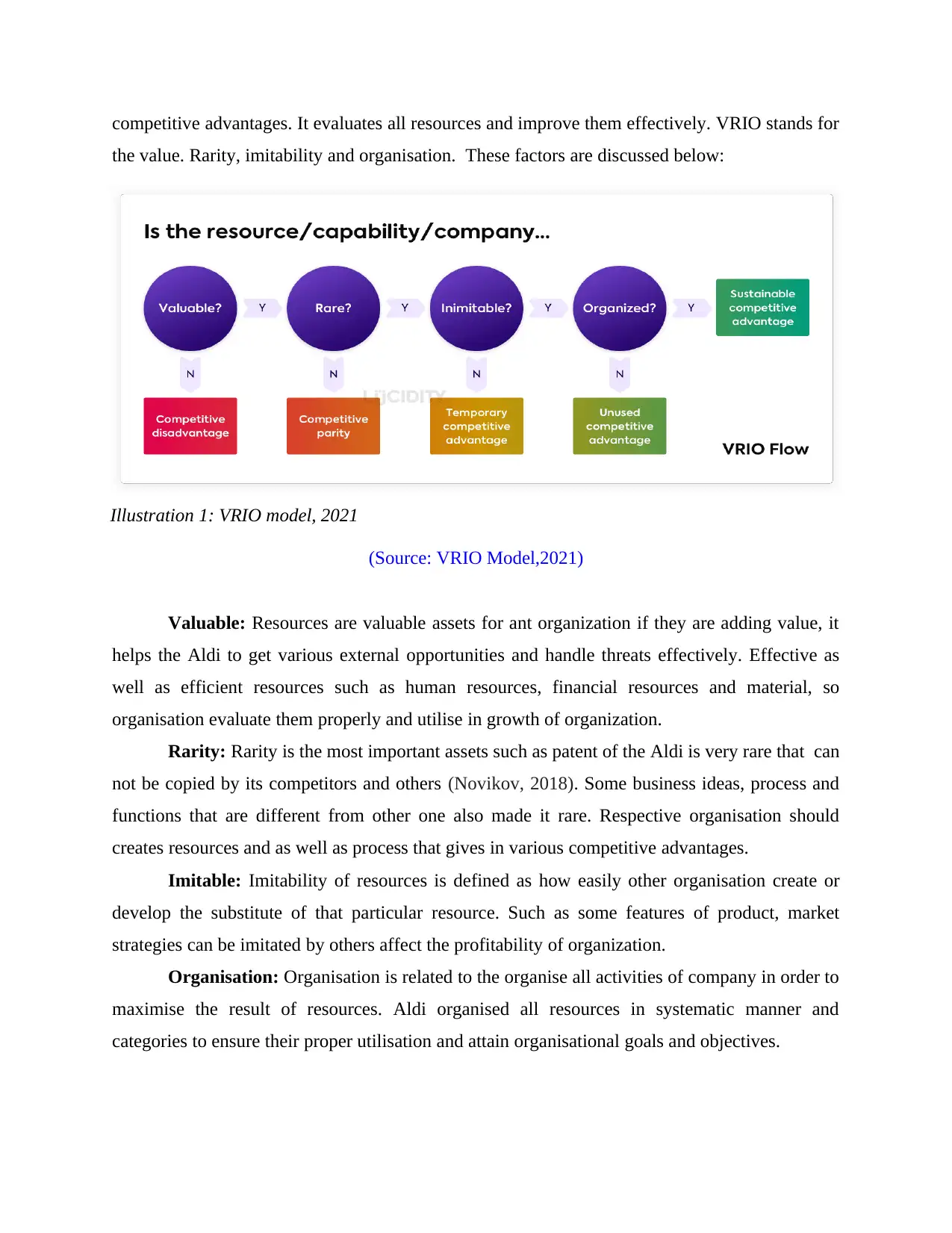
competitive advantages. It evaluates all resources and improve them effectively. VRIO stands for
the value. Rarity, imitability and organisation. These factors are discussed below:
(Source: VRIO Model,2021)
Valuable: Resources are valuable assets for ant organization if they are adding value, it
helps the Aldi to get various external opportunities and handle threats effectively. Effective as
well as efficient resources such as human resources, financial resources and material, so
organisation evaluate them properly and utilise in growth of organization.
Rarity: Rarity is the most important assets such as patent of the Aldi is very rare that can
not be copied by its competitors and others (Novikov, 2018). Some business ideas, process and
functions that are different from other one also made it rare. Respective organisation should
creates resources and as well as process that gives in various competitive advantages.
Imitable: Imitability of resources is defined as how easily other organisation create or
develop the substitute of that particular resource. Such as some features of product, market
strategies can be imitated by others affect the profitability of organization.
Organisation: Organisation is related to the organise all activities of company in order to
maximise the result of resources. Aldi organised all resources in systematic manner and
categories to ensure their proper utilisation and attain organisational goals and objectives.
Illustration 1: VRIO model, 2021
the value. Rarity, imitability and organisation. These factors are discussed below:
(Source: VRIO Model,2021)
Valuable: Resources are valuable assets for ant organization if they are adding value, it
helps the Aldi to get various external opportunities and handle threats effectively. Effective as
well as efficient resources such as human resources, financial resources and material, so
organisation evaluate them properly and utilise in growth of organization.
Rarity: Rarity is the most important assets such as patent of the Aldi is very rare that can
not be copied by its competitors and others (Novikov, 2018). Some business ideas, process and
functions that are different from other one also made it rare. Respective organisation should
creates resources and as well as process that gives in various competitive advantages.
Imitable: Imitability of resources is defined as how easily other organisation create or
develop the substitute of that particular resource. Such as some features of product, market
strategies can be imitated by others affect the profitability of organization.
Organisation: Organisation is related to the organise all activities of company in order to
maximise the result of resources. Aldi organised all resources in systematic manner and
categories to ensure their proper utilisation and attain organisational goals and objectives.
Illustration 1: VRIO model, 2021
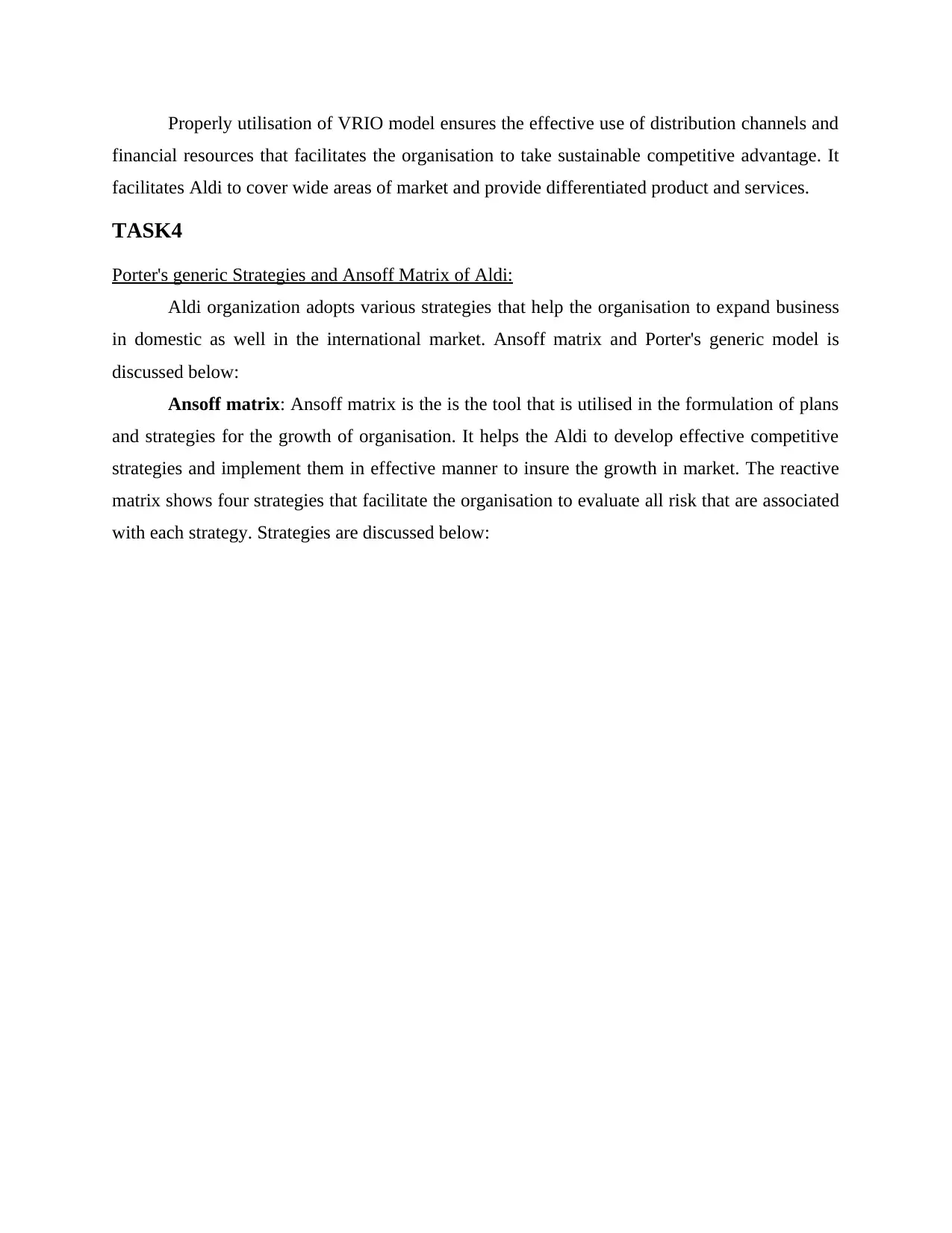
Properly utilisation of VRIO model ensures the effective use of distribution channels and
financial resources that facilitates the organisation to take sustainable competitive advantage. It
facilitates Aldi to cover wide areas of market and provide differentiated product and services.
TASK4
Porter's generic Strategies and Ansoff Matrix of Aldi:
Aldi organization adopts various strategies that help the organisation to expand business
in domestic as well in the international market. Ansoff matrix and Porter's generic model is
discussed below:
Ansoff matrix: Ansoff matrix is the is the tool that is utilised in the formulation of plans
and strategies for the growth of organisation. It helps the Aldi to develop effective competitive
strategies and implement them in effective manner to insure the growth in market. The reactive
matrix shows four strategies that facilitate the organisation to evaluate all risk that are associated
with each strategy. Strategies are discussed below:
financial resources that facilitates the organisation to take sustainable competitive advantage. It
facilitates Aldi to cover wide areas of market and provide differentiated product and services.
TASK4
Porter's generic Strategies and Ansoff Matrix of Aldi:
Aldi organization adopts various strategies that help the organisation to expand business
in domestic as well in the international market. Ansoff matrix and Porter's generic model is
discussed below:
Ansoff matrix: Ansoff matrix is the is the tool that is utilised in the formulation of plans
and strategies for the growth of organisation. It helps the Aldi to develop effective competitive
strategies and implement them in effective manner to insure the growth in market. The reactive
matrix shows four strategies that facilitate the organisation to evaluate all risk that are associated
with each strategy. Strategies are discussed below:
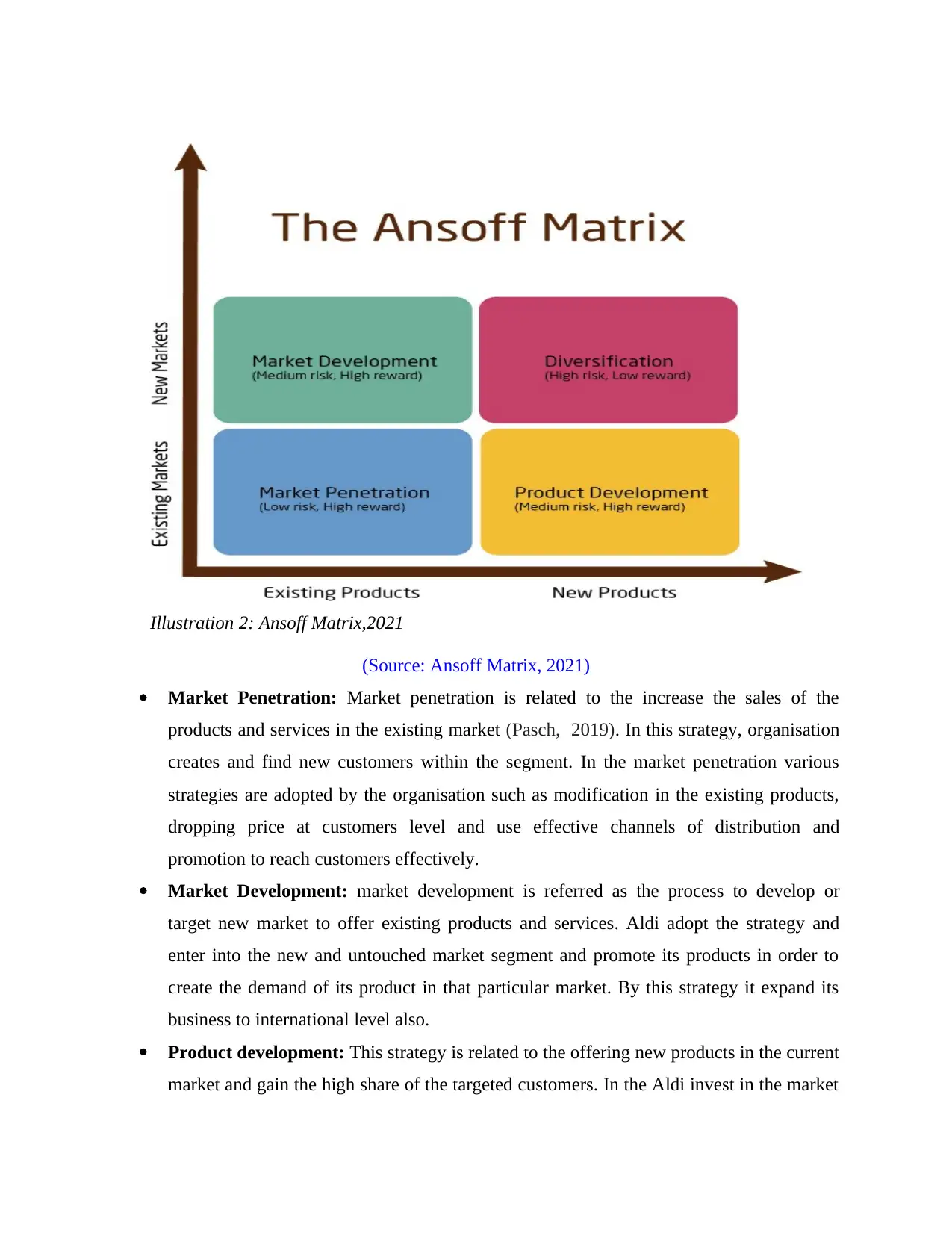
(Source: Ansoff Matrix, 2021)
Market Penetration: Market penetration is related to the increase the sales of the
products and services in the existing market (Pasch, 2019). In this strategy, organisation
creates and find new customers within the segment. In the market penetration various
strategies are adopted by the organisation such as modification in the existing products,
dropping price at customers level and use effective channels of distribution and
promotion to reach customers effectively.
Market Development: market development is referred as the process to develop or
target new market to offer existing products and services. Aldi adopt the strategy and
enter into the new and untouched market segment and promote its products in order to
create the demand of its product in that particular market. By this strategy it expand its
business to international level also.
Product development: This strategy is related to the offering new products in the current
market and gain the high share of the targeted customers. In the Aldi invest in the market
Illustration 2: Ansoff Matrix,2021
Market Penetration: Market penetration is related to the increase the sales of the
products and services in the existing market (Pasch, 2019). In this strategy, organisation
creates and find new customers within the segment. In the market penetration various
strategies are adopted by the organisation such as modification in the existing products,
dropping price at customers level and use effective channels of distribution and
promotion to reach customers effectively.
Market Development: market development is referred as the process to develop or
target new market to offer existing products and services. Aldi adopt the strategy and
enter into the new and untouched market segment and promote its products in order to
create the demand of its product in that particular market. By this strategy it expand its
business to international level also.
Product development: This strategy is related to the offering new products in the current
market and gain the high share of the targeted customers. In the Aldi invest in the market
Illustration 2: Ansoff Matrix,2021
Secure Best Marks with AI Grader
Need help grading? Try our AI Grader for instant feedback on your assignments.
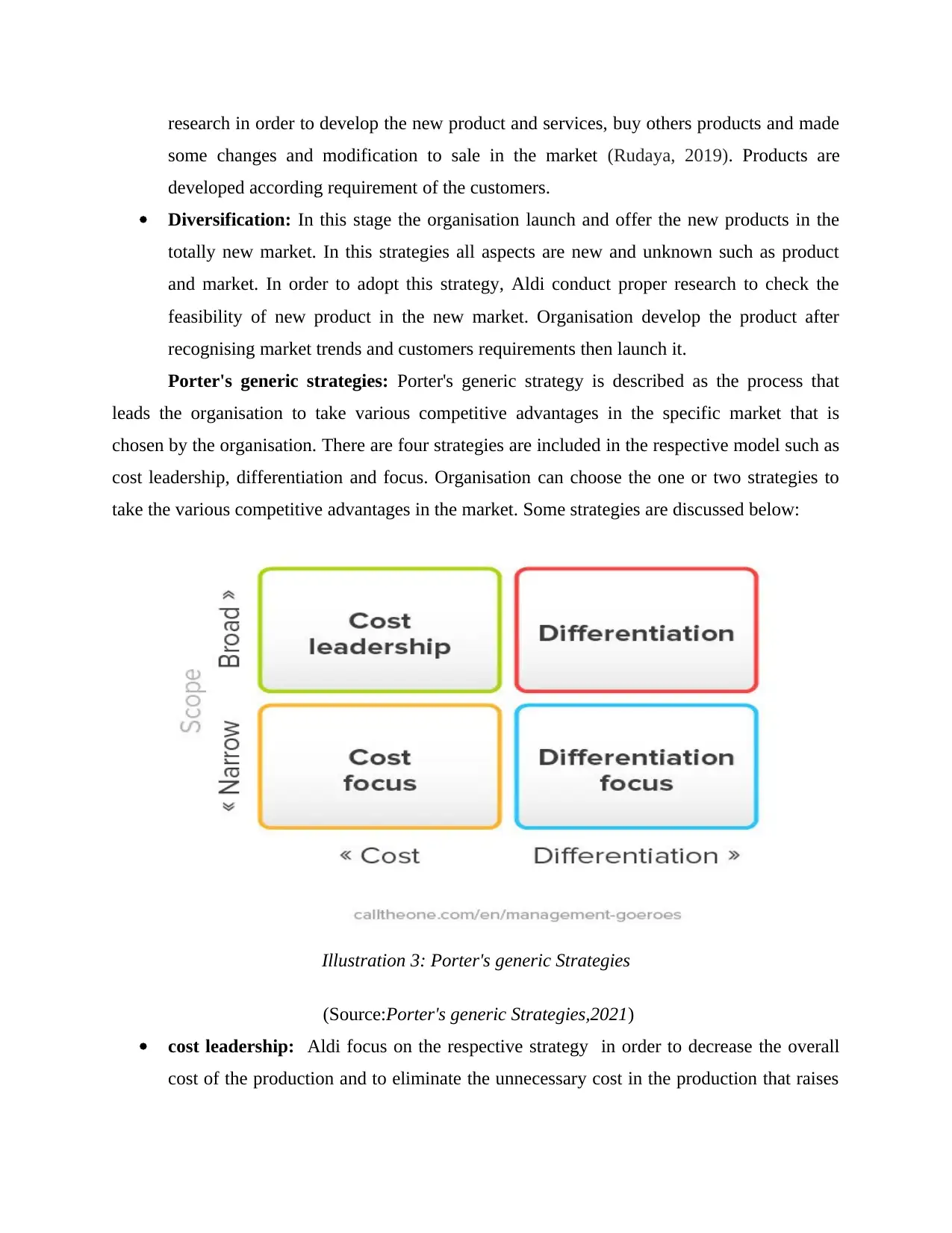
research in order to develop the new product and services, buy others products and made
some changes and modification to sale in the market (Rudaya, 2019). Products are
developed according requirement of the customers.
Diversification: In this stage the organisation launch and offer the new products in the
totally new market. In this strategies all aspects are new and unknown such as product
and market. In order to adopt this strategy, Aldi conduct proper research to check the
feasibility of new product in the new market. Organisation develop the product after
recognising market trends and customers requirements then launch it.
Porter's generic strategies: Porter's generic strategy is described as the process that
leads the organisation to take various competitive advantages in the specific market that is
chosen by the organisation. There are four strategies are included in the respective model such as
cost leadership, differentiation and focus. Organisation can choose the one or two strategies to
take the various competitive advantages in the market. Some strategies are discussed below:
(Source:Porter's generic Strategies,2021)
cost leadership: Aldi focus on the respective strategy in order to decrease the overall
cost of the production and to eliminate the unnecessary cost in the production that raises
Illustration 3: Porter's generic Strategies
some changes and modification to sale in the market (Rudaya, 2019). Products are
developed according requirement of the customers.
Diversification: In this stage the organisation launch and offer the new products in the
totally new market. In this strategies all aspects are new and unknown such as product
and market. In order to adopt this strategy, Aldi conduct proper research to check the
feasibility of new product in the new market. Organisation develop the product after
recognising market trends and customers requirements then launch it.
Porter's generic strategies: Porter's generic strategy is described as the process that
leads the organisation to take various competitive advantages in the specific market that is
chosen by the organisation. There are four strategies are included in the respective model such as
cost leadership, differentiation and focus. Organisation can choose the one or two strategies to
take the various competitive advantages in the market. Some strategies are discussed below:
(Source:Porter's generic Strategies,2021)
cost leadership: Aldi focus on the respective strategy in order to decrease the overall
cost of the production and to eliminate the unnecessary cost in the production that raises
Illustration 3: Porter's generic Strategies
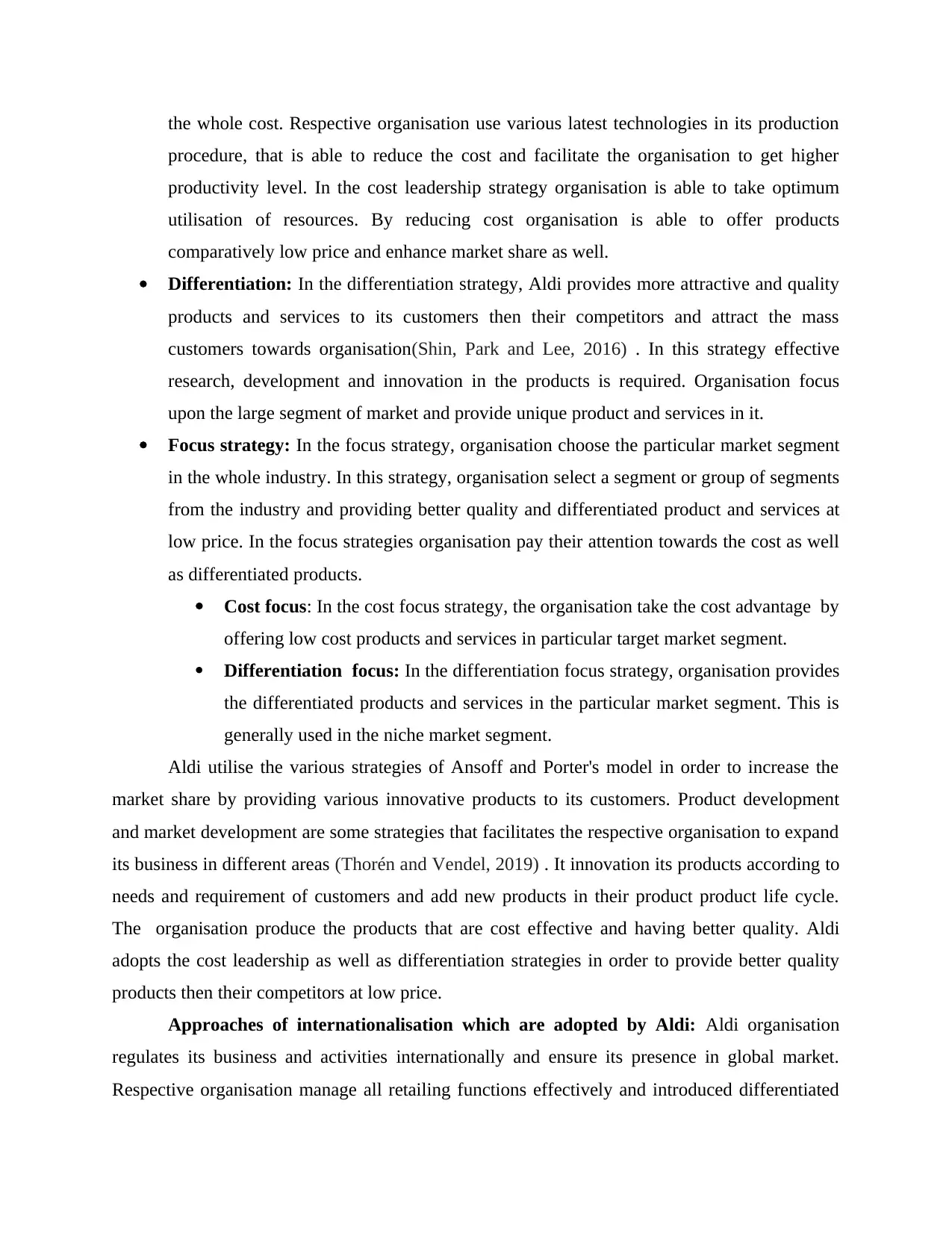
the whole cost. Respective organisation use various latest technologies in its production
procedure, that is able to reduce the cost and facilitate the organisation to get higher
productivity level. In the cost leadership strategy organisation is able to take optimum
utilisation of resources. By reducing cost organisation is able to offer products
comparatively low price and enhance market share as well.
Differentiation: In the differentiation strategy, Aldi provides more attractive and quality
products and services to its customers then their competitors and attract the mass
customers towards organisation(Shin, Park and Lee, 2016) . In this strategy effective
research, development and innovation in the products is required. Organisation focus
upon the large segment of market and provide unique product and services in it.
Focus strategy: In the focus strategy, organisation choose the particular market segment
in the whole industry. In this strategy, organisation select a segment or group of segments
from the industry and providing better quality and differentiated product and services at
low price. In the focus strategies organisation pay their attention towards the cost as well
as differentiated products.
Cost focus: In the cost focus strategy, the organisation take the cost advantage by
offering low cost products and services in particular target market segment.
Differentiation focus: In the differentiation focus strategy, organisation provides
the differentiated products and services in the particular market segment. This is
generally used in the niche market segment.
Aldi utilise the various strategies of Ansoff and Porter's model in order to increase the
market share by providing various innovative products to its customers. Product development
and market development are some strategies that facilitates the respective organisation to expand
its business in different areas (Thorén and Vendel, 2019) . It innovation its products according to
needs and requirement of customers and add new products in their product product life cycle.
The organisation produce the products that are cost effective and having better quality. Aldi
adopts the cost leadership as well as differentiation strategies in order to provide better quality
products then their competitors at low price.
Approaches of internationalisation which are adopted by Aldi: Aldi organisation
regulates its business and activities internationally and ensure its presence in global market.
Respective organisation manage all retailing functions effectively and introduced differentiated
procedure, that is able to reduce the cost and facilitate the organisation to get higher
productivity level. In the cost leadership strategy organisation is able to take optimum
utilisation of resources. By reducing cost organisation is able to offer products
comparatively low price and enhance market share as well.
Differentiation: In the differentiation strategy, Aldi provides more attractive and quality
products and services to its customers then their competitors and attract the mass
customers towards organisation(Shin, Park and Lee, 2016) . In this strategy effective
research, development and innovation in the products is required. Organisation focus
upon the large segment of market and provide unique product and services in it.
Focus strategy: In the focus strategy, organisation choose the particular market segment
in the whole industry. In this strategy, organisation select a segment or group of segments
from the industry and providing better quality and differentiated product and services at
low price. In the focus strategies organisation pay their attention towards the cost as well
as differentiated products.
Cost focus: In the cost focus strategy, the organisation take the cost advantage by
offering low cost products and services in particular target market segment.
Differentiation focus: In the differentiation focus strategy, organisation provides
the differentiated products and services in the particular market segment. This is
generally used in the niche market segment.
Aldi utilise the various strategies of Ansoff and Porter's model in order to increase the
market share by providing various innovative products to its customers. Product development
and market development are some strategies that facilitates the respective organisation to expand
its business in different areas (Thorén and Vendel, 2019) . It innovation its products according to
needs and requirement of customers and add new products in their product product life cycle.
The organisation produce the products that are cost effective and having better quality. Aldi
adopts the cost leadership as well as differentiation strategies in order to provide better quality
products then their competitors at low price.
Approaches of internationalisation which are adopted by Aldi: Aldi organisation
regulates its business and activities internationally and ensure its presence in global market.
Respective organisation manage all retailing functions effectively and introduced differentiated
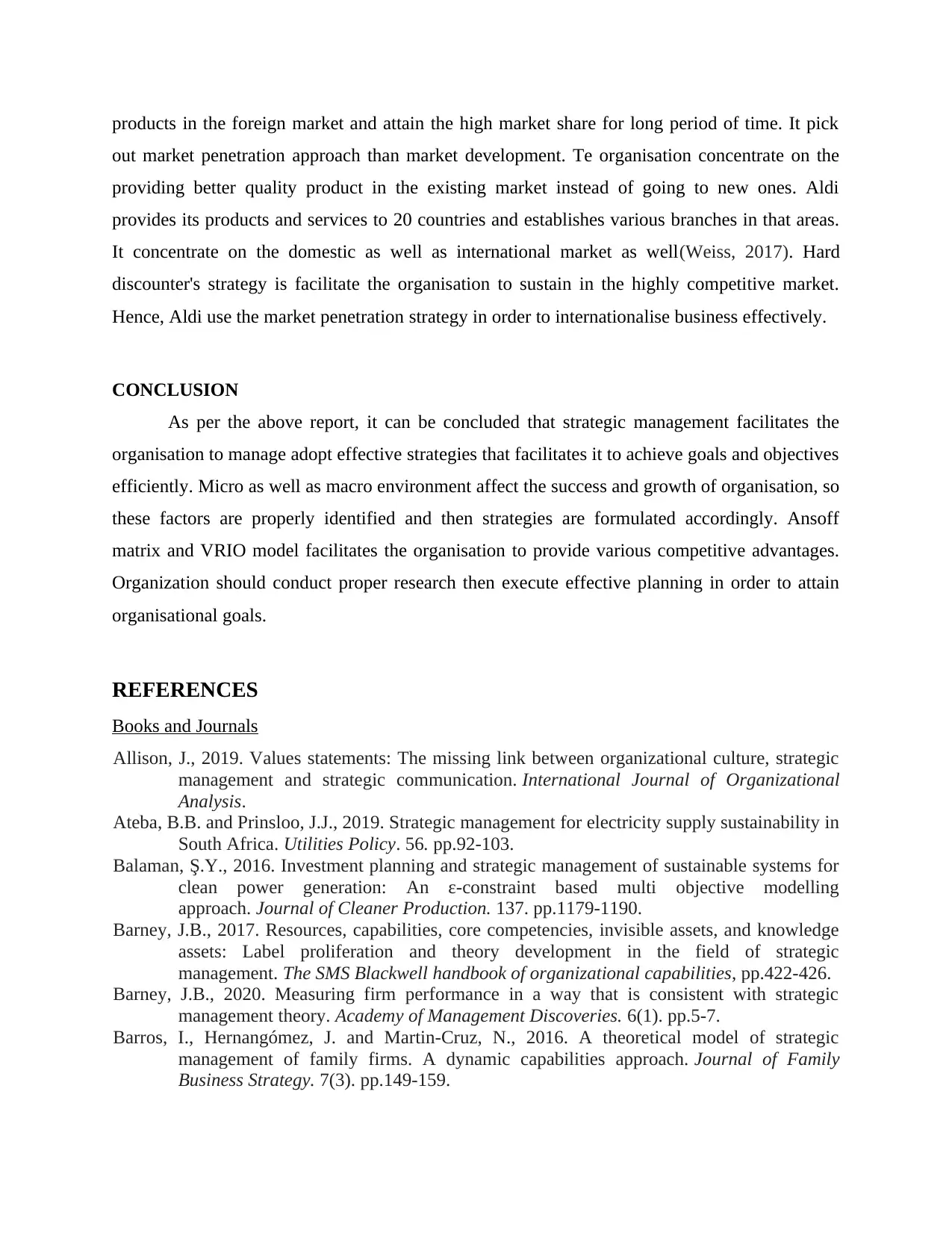
products in the foreign market and attain the high market share for long period of time. It pick
out market penetration approach than market development. Te organisation concentrate on the
providing better quality product in the existing market instead of going to new ones. Aldi
provides its products and services to 20 countries and establishes various branches in that areas.
It concentrate on the domestic as well as international market as well(Weiss, 2017). Hard
discounter's strategy is facilitate the organisation to sustain in the highly competitive market.
Hence, Aldi use the market penetration strategy in order to internationalise business effectively.
CONCLUSION
As per the above report, it can be concluded that strategic management facilitates the
organisation to manage adopt effective strategies that facilitates it to achieve goals and objectives
efficiently. Micro as well as macro environment affect the success and growth of organisation, so
these factors are properly identified and then strategies are formulated accordingly. Ansoff
matrix and VRIO model facilitates the organisation to provide various competitive advantages.
Organization should conduct proper research then execute effective planning in order to attain
organisational goals.
REFERENCES
Books and Journals
Allison, J., 2019. Values statements: The missing link between organizational culture, strategic
management and strategic communication. International Journal of Organizational
Analysis.
Ateba, B.B. and Prinsloo, J.J., 2019. Strategic management for electricity supply sustainability in
South Africa. Utilities Policy. 56. pp.92-103.
Balaman, Ş.Y., 2016. Investment planning and strategic management of sustainable systems for
clean power generation: An ε-constraint based multi objective modelling
approach. Journal of Cleaner Production. 137. pp.1179-1190.
Barney, J.B., 2017. Resources, capabilities, core competencies, invisible assets, and knowledge
assets: Label proliferation and theory development in the field of strategic
management. The SMS Blackwell handbook of organizational capabilities, pp.422-426.
Barney, J.B., 2020. Measuring firm performance in a way that is consistent with strategic
management theory. Academy of Management Discoveries. 6(1). pp.5-7.
Barros, I., Hernangómez, J. and Martin-Cruz, N., 2016. A theoretical model of strategic
management of family firms. A dynamic capabilities approach. Journal of Family
Business Strategy. 7(3). pp.149-159.
out market penetration approach than market development. Te organisation concentrate on the
providing better quality product in the existing market instead of going to new ones. Aldi
provides its products and services to 20 countries and establishes various branches in that areas.
It concentrate on the domestic as well as international market as well(Weiss, 2017). Hard
discounter's strategy is facilitate the organisation to sustain in the highly competitive market.
Hence, Aldi use the market penetration strategy in order to internationalise business effectively.
CONCLUSION
As per the above report, it can be concluded that strategic management facilitates the
organisation to manage adopt effective strategies that facilitates it to achieve goals and objectives
efficiently. Micro as well as macro environment affect the success and growth of organisation, so
these factors are properly identified and then strategies are formulated accordingly. Ansoff
matrix and VRIO model facilitates the organisation to provide various competitive advantages.
Organization should conduct proper research then execute effective planning in order to attain
organisational goals.
REFERENCES
Books and Journals
Allison, J., 2019. Values statements: The missing link between organizational culture, strategic
management and strategic communication. International Journal of Organizational
Analysis.
Ateba, B.B. and Prinsloo, J.J., 2019. Strategic management for electricity supply sustainability in
South Africa. Utilities Policy. 56. pp.92-103.
Balaman, Ş.Y., 2016. Investment planning and strategic management of sustainable systems for
clean power generation: An ε-constraint based multi objective modelling
approach. Journal of Cleaner Production. 137. pp.1179-1190.
Barney, J.B., 2017. Resources, capabilities, core competencies, invisible assets, and knowledge
assets: Label proliferation and theory development in the field of strategic
management. The SMS Blackwell handbook of organizational capabilities, pp.422-426.
Barney, J.B., 2020. Measuring firm performance in a way that is consistent with strategic
management theory. Academy of Management Discoveries. 6(1). pp.5-7.
Barros, I., Hernangómez, J. and Martin-Cruz, N., 2016. A theoretical model of strategic
management of family firms. A dynamic capabilities approach. Journal of Family
Business Strategy. 7(3). pp.149-159.
Paraphrase This Document
Need a fresh take? Get an instant paraphrase of this document with our AI Paraphraser
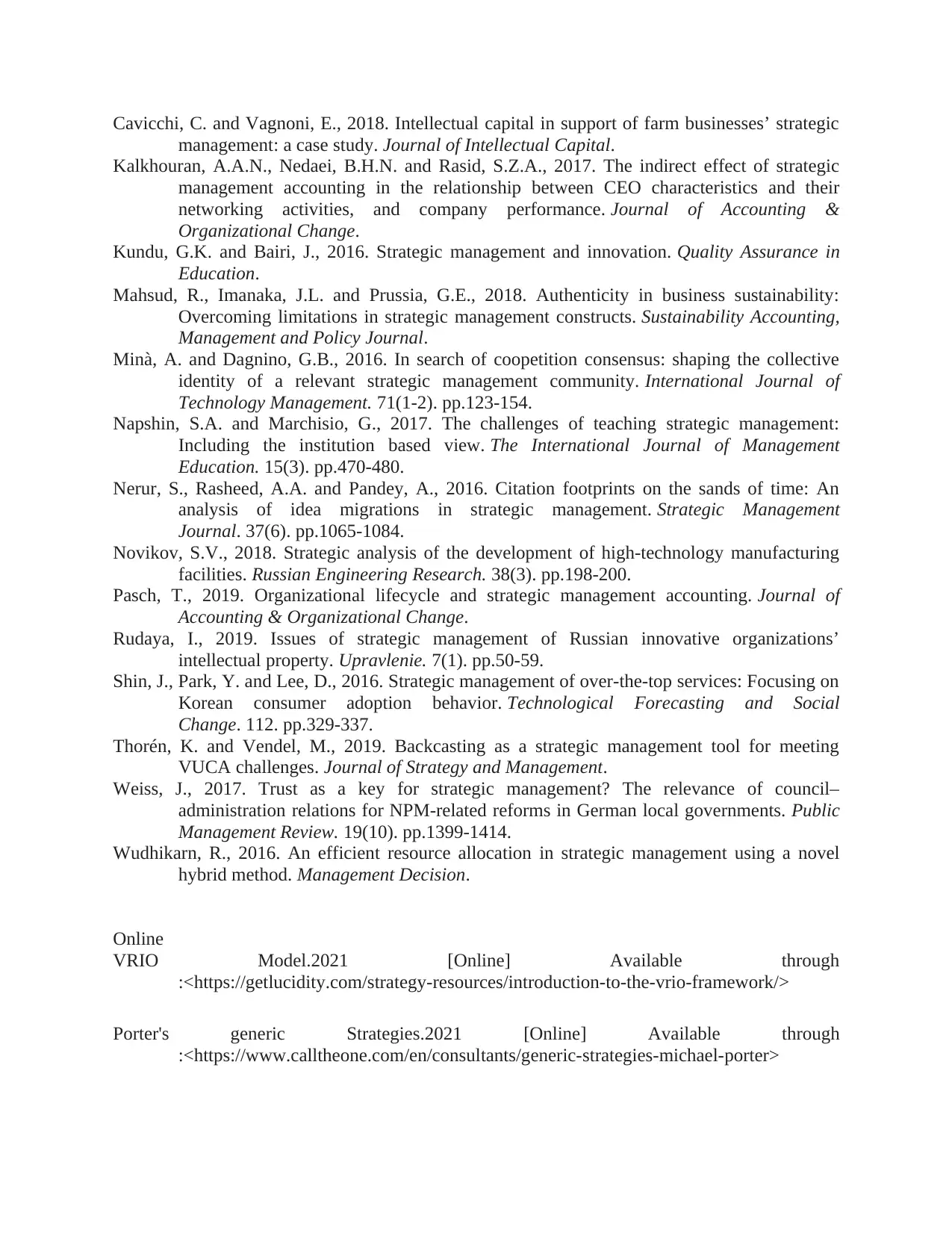
Cavicchi, C. and Vagnoni, E., 2018. Intellectual capital in support of farm businesses’ strategic
management: a case study. Journal of Intellectual Capital.
Kalkhouran, A.A.N., Nedaei, B.H.N. and Rasid, S.Z.A., 2017. The indirect effect of strategic
management accounting in the relationship between CEO characteristics and their
networking activities, and company performance. Journal of Accounting &
Organizational Change.
Kundu, G.K. and Bairi, J., 2016. Strategic management and innovation. Quality Assurance in
Education.
Mahsud, R., Imanaka, J.L. and Prussia, G.E., 2018. Authenticity in business sustainability:
Overcoming limitations in strategic management constructs. Sustainability Accounting,
Management and Policy Journal.
Minà, A. and Dagnino, G.B., 2016. In search of coopetition consensus: shaping the collective
identity of a relevant strategic management community. International Journal of
Technology Management. 71(1-2). pp.123-154.
Napshin, S.A. and Marchisio, G., 2017. The challenges of teaching strategic management:
Including the institution based view. The International Journal of Management
Education. 15(3). pp.470-480.
Nerur, S., Rasheed, A.A. and Pandey, A., 2016. Citation footprints on the sands of time: An
analysis of idea migrations in strategic management. Strategic Management
Journal. 37(6). pp.1065-1084.
Novikov, S.V., 2018. Strategic analysis of the development of high-technology manufacturing
facilities. Russian Engineering Research. 38(3). pp.198-200.
Pasch, T., 2019. Organizational lifecycle and strategic management accounting. Journal of
Accounting & Organizational Change.
Rudaya, I., 2019. Issues of strategic management of Russian innovative organizations’
intellectual property. Upravlenie. 7(1). pp.50-59.
Shin, J., Park, Y. and Lee, D., 2016. Strategic management of over-the-top services: Focusing on
Korean consumer adoption behavior. Technological Forecasting and Social
Change. 112. pp.329-337.
Thorén, K. and Vendel, M., 2019. Backcasting as a strategic management tool for meeting
VUCA challenges. Journal of Strategy and Management.
Weiss, J., 2017. Trust as a key for strategic management? The relevance of council–
administration relations for NPM-related reforms in German local governments. Public
Management Review. 19(10). pp.1399-1414.
Wudhikarn, R., 2016. An efficient resource allocation in strategic management using a novel
hybrid method. Management Decision.
Online
VRIO Model.2021 [Online] Available through
:<https://getlucidity.com/strategy-resources/introduction-to-the-vrio-framework/>
Porter's generic Strategies.2021 [Online] Available through
:<https://www.calltheone.com/en/consultants/generic-strategies-michael-porter>
management: a case study. Journal of Intellectual Capital.
Kalkhouran, A.A.N., Nedaei, B.H.N. and Rasid, S.Z.A., 2017. The indirect effect of strategic
management accounting in the relationship between CEO characteristics and their
networking activities, and company performance. Journal of Accounting &
Organizational Change.
Kundu, G.K. and Bairi, J., 2016. Strategic management and innovation. Quality Assurance in
Education.
Mahsud, R., Imanaka, J.L. and Prussia, G.E., 2018. Authenticity in business sustainability:
Overcoming limitations in strategic management constructs. Sustainability Accounting,
Management and Policy Journal.
Minà, A. and Dagnino, G.B., 2016. In search of coopetition consensus: shaping the collective
identity of a relevant strategic management community. International Journal of
Technology Management. 71(1-2). pp.123-154.
Napshin, S.A. and Marchisio, G., 2017. The challenges of teaching strategic management:
Including the institution based view. The International Journal of Management
Education. 15(3). pp.470-480.
Nerur, S., Rasheed, A.A. and Pandey, A., 2016. Citation footprints on the sands of time: An
analysis of idea migrations in strategic management. Strategic Management
Journal. 37(6). pp.1065-1084.
Novikov, S.V., 2018. Strategic analysis of the development of high-technology manufacturing
facilities. Russian Engineering Research. 38(3). pp.198-200.
Pasch, T., 2019. Organizational lifecycle and strategic management accounting. Journal of
Accounting & Organizational Change.
Rudaya, I., 2019. Issues of strategic management of Russian innovative organizations’
intellectual property. Upravlenie. 7(1). pp.50-59.
Shin, J., Park, Y. and Lee, D., 2016. Strategic management of over-the-top services: Focusing on
Korean consumer adoption behavior. Technological Forecasting and Social
Change. 112. pp.329-337.
Thorén, K. and Vendel, M., 2019. Backcasting as a strategic management tool for meeting
VUCA challenges. Journal of Strategy and Management.
Weiss, J., 2017. Trust as a key for strategic management? The relevance of council–
administration relations for NPM-related reforms in German local governments. Public
Management Review. 19(10). pp.1399-1414.
Wudhikarn, R., 2016. An efficient resource allocation in strategic management using a novel
hybrid method. Management Decision.
Online
VRIO Model.2021 [Online] Available through
:<https://getlucidity.com/strategy-resources/introduction-to-the-vrio-framework/>
Porter's generic Strategies.2021 [Online] Available through
:<https://www.calltheone.com/en/consultants/generic-strategies-michael-porter>
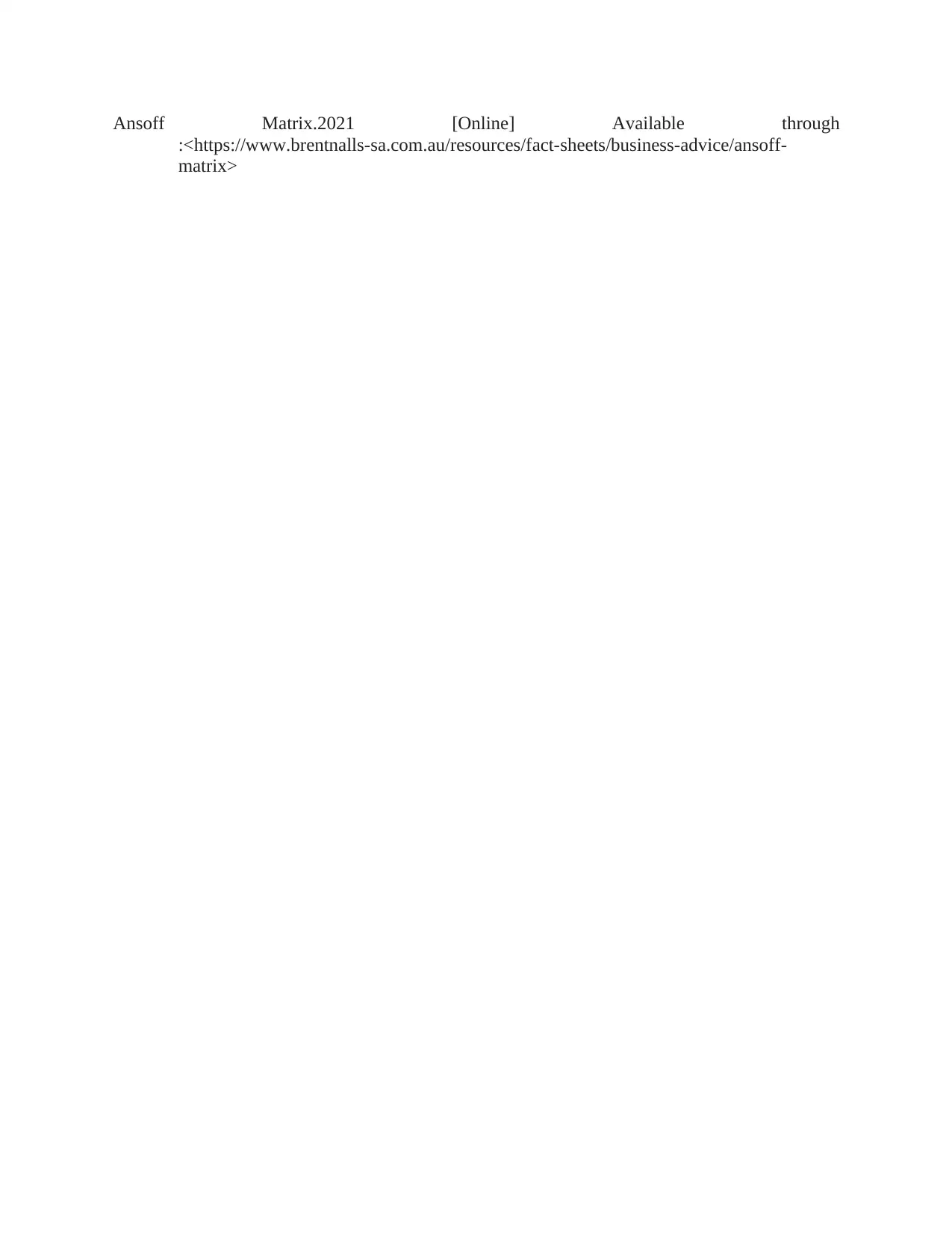
Ansoff Matrix.2021 [Online] Available through
:<https://www.brentnalls-sa.com.au/resources/fact-sheets/business-advice/ansoff-
matrix>
:<https://www.brentnalls-sa.com.au/resources/fact-sheets/business-advice/ansoff-
matrix>

Secure Best Marks with AI Grader
Need help grading? Try our AI Grader for instant feedback on your assignments.

1 out of 23
Related Documents
Your All-in-One AI-Powered Toolkit for Academic Success.
+13062052269
info@desklib.com
Available 24*7 on WhatsApp / Email
![[object Object]](/_next/static/media/star-bottom.7253800d.svg)
Unlock your academic potential
© 2024 | Zucol Services PVT LTD | All rights reserved.





